Replacing Your Standing Rigging
Published by rigworks on november 27, 2018.
Question – When should I replace my standing rigging?
From the Rigger – According to industry standards, the anticipated lifespan for stainless steel rigging is 10-12 years for wire and 15-20 years for rod. Of course, a number of factors affect a rig’s lifespan including load, sailing conditions, mileage sailed, age, fatigue from cyclic loading, environmental influences such as salinity and contamination, and frequency of care and maintenance. Many people believe that only heavily used rigging needs to be replaced, but the continuous flexing of loose wire that is not under load can take a serious toll as well. The flogging of a loose shroud can actually be harder on wire than steady pressure.
Unfortunately, there are not always visual clues that your rigging has passed its life expectancy. Things to look for include corrosion, pitting, cracks, and broken strands or “meat hooks” on the wire. Rust and discoloration can indicate the location of a crack or crystallization of the metal. Check your spreaders, chainplates and turnbuckles for cracking, fatigue, missing cotter pins/rings, etc. Check the deck around the chainplates and mast for cracking and delamination. If in doubt, get a professional opinion.
The cost to replace standing rigging obviously varies from boat to boat. Give us a call, and we can give you a rough quote. With proper measurements (wire diameter, pin sizes, wire lengths), we can give you a very accurate price for the standing rigging itself, but there are often unforeseen complications during the job (bad spreaders, corroded mast bases, hardware that is stripped on the mast, frozen pins, chainplates that are failing, etc.). A rig inspection beforehand can minimize surprises. And word of warning… jobs often get expensive because the customer decides, once the mast is down, to add furlers, masthead units, new sheets and halyards, etc. These additions add up quickly and affect the cost of parts, labor, special order shipping, taxes, etc. We are happy to accommodate your requests, but the cost of your job will escalate quickly.
Although we work closely with the boatyard during the job, you will need to negotiate yard fees (crane, mast lay days, etc.) directly with the yard of your choice. They are not included in our estimate. Driscoll Boat Works and Shelter Island Boat Yard are both within walking distance of Rigworks. Assuming it fits in our racks and we have room, we may be able to avoid mast lay day charges by storing your mast here at Rigworks.
As a quick side note… people often ask if they should switch from rod to wire rigging or vice versa during the re-rig (usually from rod to wire as rod is much more expensive per foot). Be aware that this is not a simple conversion and can be quite expensive. The terminations for wire vs. rod can be quite different and require a lot of customization.
Want to prolong the lifespan of your rigging? Here are a few suggestions…
Maintain your standing rigging! Like your car, your sailboat needs TLC. Perform routine cleaning/polishing to remove corrosives, identify chafe points and other damage, and properly tune your standing rigging (shrouds, forestay, backstay). Stainless does not like to be deprived of oxygen, so keep tape off your rigging to avoid anaerobic corrosion. For more information on rig maintenance, visit our prior ‘Ask the Rigger’ article at https://rigworks.com/maintaining-your-standing-rigging/ and download our rig-care pamphlet at https://rigworks.com/wp-content/uploads/2016/03/Standing-Rigging-Care.pdf .
Get regular rig inspections! This is a very inexpensive investment (by yachting standards ) to ensure that your rig is in sound condition. Why not schedule annual service as you would with a car? Let us go over your rig from top to bottom and end to end to identify trouble before it gets worse. For more information on rig inspections, visit our prior ‘Ask the Rigger’ article at https://rigworks.com/the-scoop-on-rig-inspections/ . Our riggers can also tune your rig, either at the dock or under sail. Not only will your rig last longer when properly tuned, your boat will sail better, and who doesn’t love that!
Consider pulling your rig every 5-6 years to inspect the mast base, chainplates, turnbuckles, wire, etc. This is considerably less expensive than a full re-rig and, again, may identify issues before they become catastrophic.
And PLEASE do not buy a used boat without a professional rig inspection! We have had many customers who have found a ‘great deal’ on a used boat only to discover that they need to spend a small fortune on new rigging. A boat with bad rigging is at best a pain in the #@$ and at worst a lethal weapon. There is nothing more expensive than a “cheap” boat!
A customer came into our shop the other day to discuss his 33-year old rigging. He said it looked fine. He asked “Isn’t the industry standard just a ploy by manufacturers to sell more wire”. Since we also stand to gain when you replace your rigging, let us say that many insurance companies will not insure sailboats with aged rigging. This should be a warning. If they are not willing to take the financial risk, are you willing to risk yourself and your crew?
Finally, should you decide to sail with that old rigging, consider checking out the ‘Ask the Rigger’ article titled “Rigs Fail… Are You Ready?” at https://rigworks.com/rigs-fail-ready/ .
Safe Sailing!
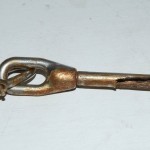

Related Posts
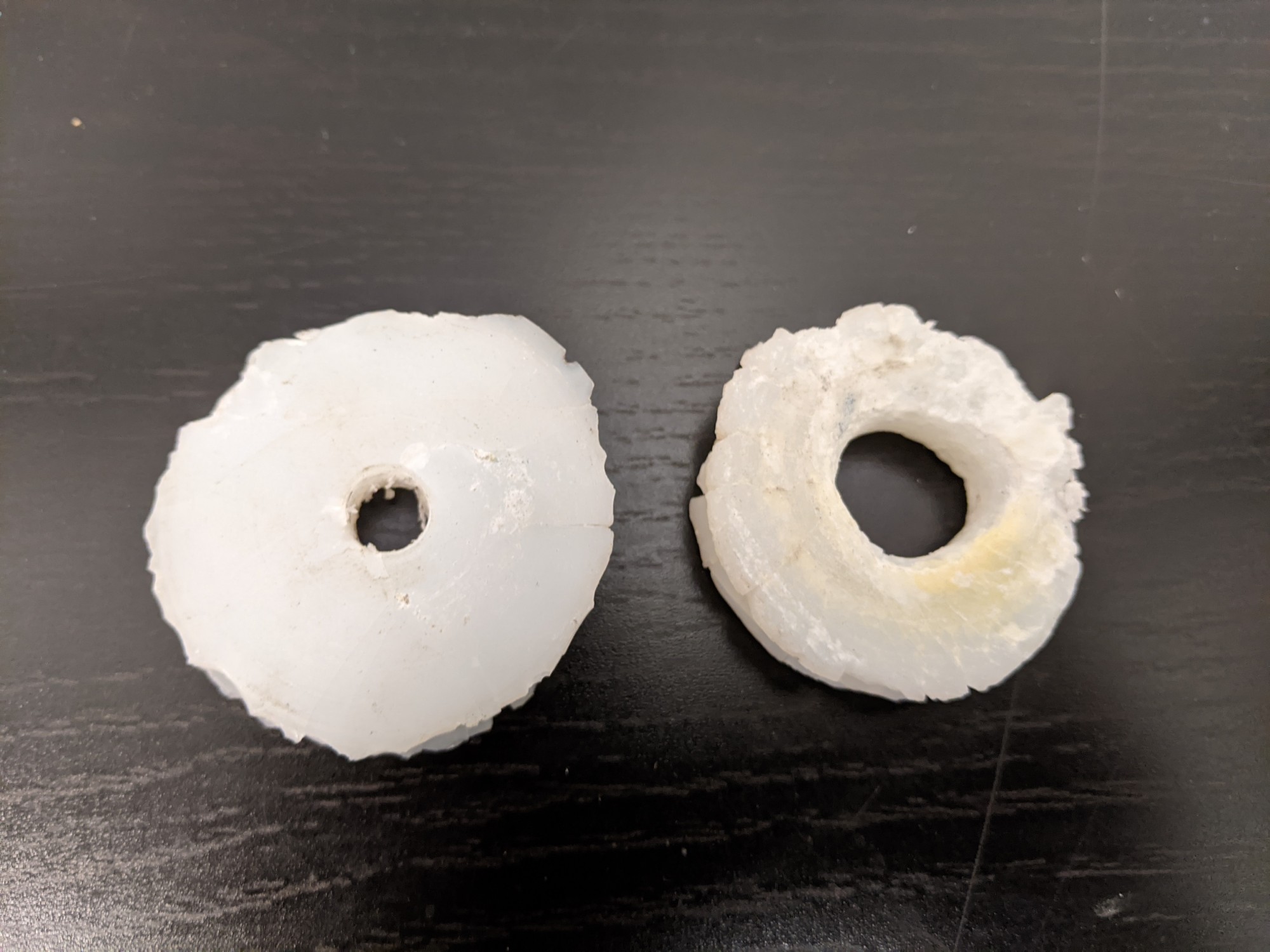
Ask the Rigger
Do your masthead sheaves need replacing.
Question: My halyard is binding. What’s up? From the Rigger: Most boat owners do not climb their masts regularly, but our riggers spend a lot of time up there. And they often find badly damaged Read more…
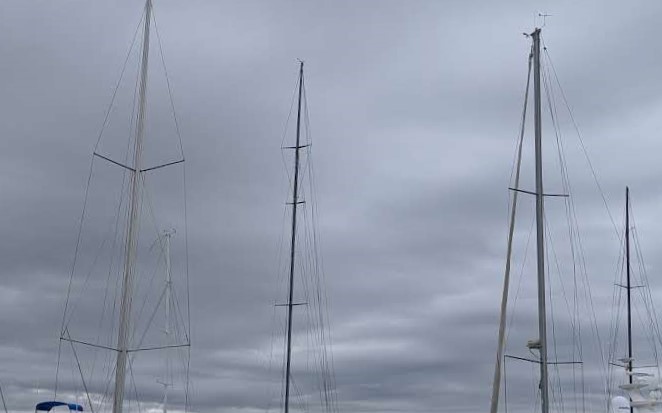
Standing Rigging (or ‘Name That Stay’)
Question: When your riggers talk about standing rigging, they often use terms I don’t recognize. Can you break it down for me? From the Rigger: Let’s play ‘Name that Stay’… Forestay (1 or HS) – Read more…
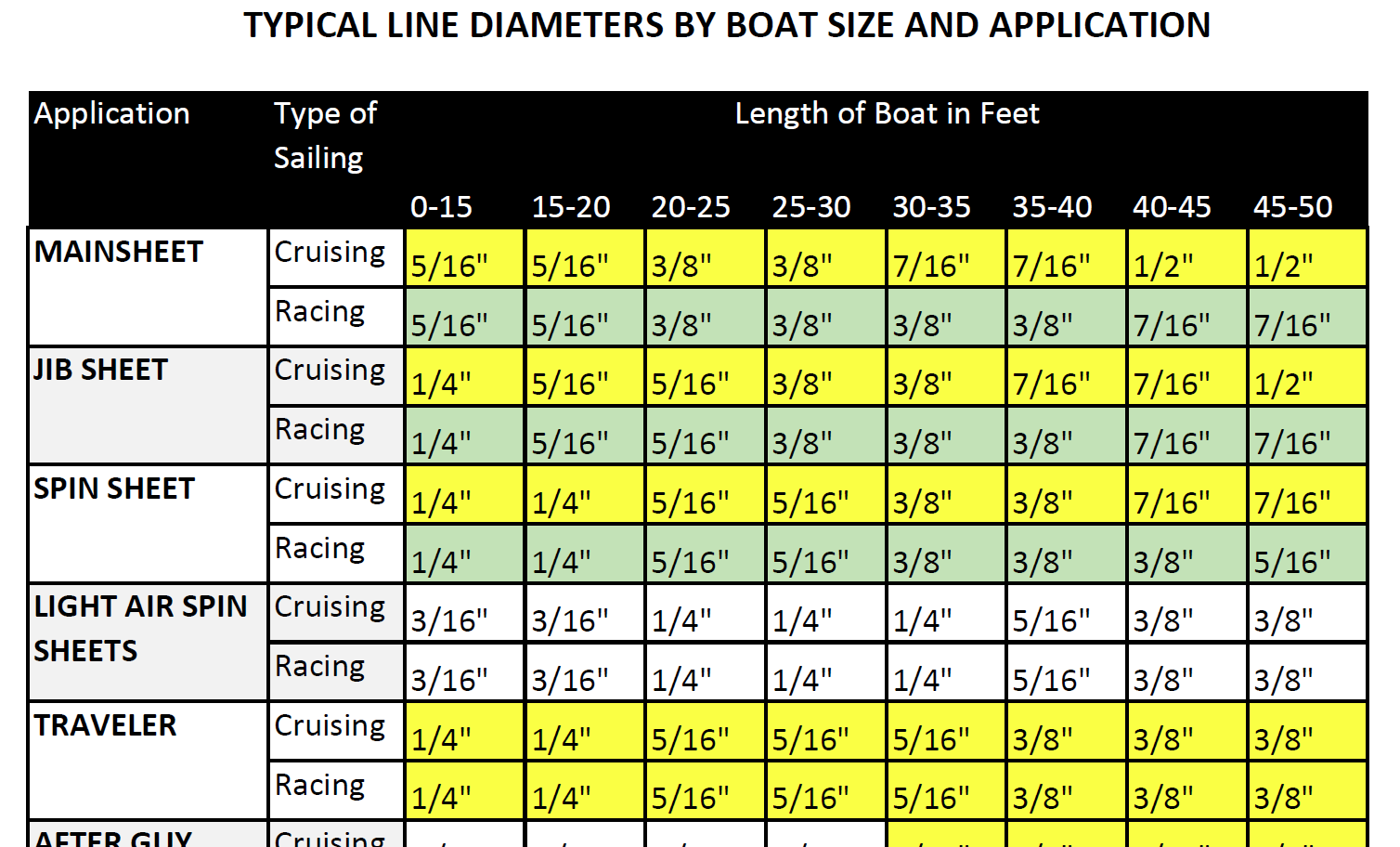
Selecting Rope – Length, Diameter, Type
Question: Do you have guidelines for selecting halyards, sheets, etc. for my sailboat? From the Rigger: First, if your old rope served its purpose but needs replacing, we recommend duplicating it as closely as possible Read more…

Berthon Winter Collection

Latest issue

August 2024
In the August 2024 issue of Yachting World magazine: News Few finish a tempestuous Round The Island Race European rules are eased for cruising to France and Greece Olympic sailing…

Yachting World
- Digital Edition

Pip Hare explains when to check and replace your standing rigging
- October 1, 2020
To prepare my IMOCA 60 Medallia for the Vendée Globe race, I have completed a full change of all the standing rigging

If the mast is stepped, the only way to thoroughly inspect rig fittings at the masthead is to go up there... Photo: James Mitchell
This was a ‘no brainer’ decision as my rigging has been around the world once already and I would never take it into the Southern Ocean for a second time.
In some ways it is easier to estimate the life of synthetic rigging, as it comes with a recommended mileage or stated lifespan if it can be UV damaged. For those with stainless steel rigging the decision on when to replace can be a harder one.
The main difficulties boat owners face when assessing the condition of the rig is the inability to see the first signs of wear, partly due to the majority of our rigging being out of sight in the sky, and partly due to the nature of metal fatigue itself.

Professional rig checks often lead to last-minute repairs for transatlantic ARC sailors. Photo: James Mitchell
The fact is that metal fatigue is inevitable and cannot be avoided. The only thing that will vary is the time a component takes to fail. So how can we make a good assessment of when rigging should be replaced?
There are a number of factors that will affect the lifespan of your standing rigging, most notably the initial quality of the rigging used and the type and frequency of sailing that you do.
Rigging quality
The quality of both wire and rod rigging is important because in both the crack initiation and growth phases of the fatigue process can be accelerated by metal impurities or unseen manufacturing defects in the component itself. Using high quality wire rigging from a well known supplier is a bigger initial outlay but the grade of metal used and manufacturing process should prolong the life of your rigging.
Article continues below…

How to prepare your yacht for anything: Preempting chafe, rig and crew problems
This is Part 2 of Vicky Ellis’ guide to preparing your yacht for any eventuality. You can read Part 1…
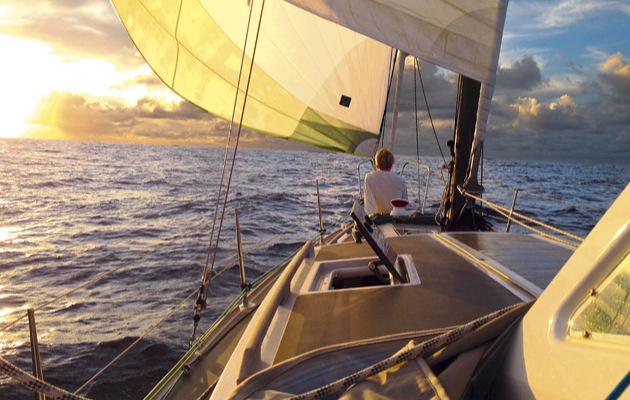
Ocean damage – tales of chafe, jury rigs and a shark on the rudder in the ARC
Crossing the Atlantic is hard on your gear, as the reports of ocean damage during the annual Atlantic Rally for…
When buying a secondhand boat, find out when the rigging was last replaced and try to get a copy of the invoice detailing who the supplier was – if you’re not sure, ask a rigger to take a look at it.
How you sail
In crude terms, every time your boat is used it is advancing the process of metal fatigue through the application of cyclical loads, so a boat that is raced regularly and hard will be approaching the point at which rigging failure could occur faster than a boat which is cruised intermittently.
This doesn’t mean that lightly used boats will never have to consider changing their rigging; even a dormant boat will be experiencing load cycles in some form when the mast is up. Just the action of the wind on a mast is enough to load up the rigging and any stays left loose will move with wind and wave action.

It’s not unusual for rigging wires to fracture around the swage collar
To minimise the stress caused by these load cycles while sailing it’s important to tune your rig regularly so the rigging is always at optimum tension. This will help ensure that changes in load are less extreme.
If you are not confident to set up your own rig tensions then ask your rigger to help, and later be sure to check your rig throughout the season.
Regular rigging checks
There are a couple of ways to test for early signs of fatigue not picked up by the naked eye; they include dye and NDT (non-destructive testing).

Water can enter swage terminals leading to crevis corrosion. Photo: Rupert Holmes
Both these surveys need to be carried out with the rig down and it may be worth balancing the overall cost of carrying out the test against the additional cost of re-rigging the boat, especially bearing in mind that if any faults or impurities are discovered your insurance may then require you to change the rigging anyway.
Regular visual checks should pick up the first signs of crack growth. Look for rust on T-terminals and at swage ends, check for powdery corrosion where T-terminals insert into the mast and any signs of cracking in the same area.
Run your fingers up and down the last metre of wire above or below the swage, feeling for deformities; if the wire is not uniform the chances are that one of the individual wires has broken, even if you can’t see it, and the stay and its partner should be replaced immediately.

Visual checks for rust and powdery corrosion are your first line of defence. Photo: Rupert Holmes
Checking the head of T-terminals is a harder job as they are inside the mast itself. This will need to be done with the mast removed so a full ‘mast down’ survey carried out by a professional rigger should be scheduled at least every three years.
Picking up early signs of corrosion or replacing select components after a thorough inspection is a worthwhile exercise because it may extend the lifespan of your standing rigging.
Inevitably your insurance policy will play a big part in your decision making about whether to replace your rigging. There has been a general assumption within the sailing community that insurance companies require rigging to be replaced after ten years, but I’ve found this is not actually the case; it’s far less prescriptive than that.

A small crack has developed in this stemhead fitting just above the forestay clevis pin
The IPID (Insurance Product Information Document) with your policy should give you a clear indication of what is covered in the event of a dismasting and may also provide some food for thought on when you should replace.
Insurance companies do not stipulate a timeframe at which your standing rigging should be replaced, but they do stipulate that all parts of the boat should be regularly and appropriately checked and maintained.
In the event of a dismasting claim, the insurance company would expect to see evidence of rigging maintenance and checks carried out at appropriate intervals by a qualified person; DIY inspections will not be accepted.
It is also worth taking note that in most insurance policies a depreciation element will be applied. This normally constitutes a deduction of one third of the new value of a rig and would start to come into play when a rig approaches 10-12 years old.
Emotional cost
There’s a consequential impact of a dismasting which cannot be covered by an insurance claim, and that is the human and emotional cost. In my own sailing career I’ve had two failures of standing rigging components which I spotted while sailing and was able to jury rig for a safe return to port. I’ve also experienced a dismasting, and I can vouch that it’s not a pleasant experience.
As a regular racer I take the health of my rig very seriously, perform checks before every major race and take my rig down annually for a thorough inspection. But this is the schedule that is right for me and the miles I sail, and would be considered overkill for the average sailor. Only you can give a proper evaluation of how often and how hard your boat is used, but that makes you ultimately responsible for setting the maintenance and replacement schedule.
Metal fatigue

Wires can break, unseen, within swaged terminals
Crack initiation starts when the metal first gets put to work and is caused by the cyclical loading of metal components. In the case of standing rigging on a sailing boat, this is the loading and unloading of shrouds and stays. Think about the windward shrouds loading up, while the leeward side relaxes: this cyclical loading causes cell structures to develop within the metal, these cells gradually harden and then develop microscopic cracks.
The crack growth stage follows next and these microscopic cracks will develop into larger ones, which may eventually be visible to the naked eye on the surface of the metal component. The speed of the crack growth phase will alter depending on how often and how hard your rigging is put under load.
Ultimate failure is caused when a crack exceeds a size that results in the component no longer supporting load. Failure will be sudden.
First published in the September 2020 issue of Yachting World.

Currency: GBP
- Worldwide Delivery
Mooring Warps and Mooring Lines
- LIROS 3 Strand Polyester Mooring Warps
- LIROS Green Wave 3 Strand Mooring Warps
- LIROS Braided Dockline Mooring Warps
- LIROS Handy Elastic Mooring Warps
- Marlow Blue Ocean Dockline
- LIROS Super Yacht Mooring Polyester Docklines
- 50 metre / 100 metre Rates - Mooring
Mooring Accessories
- Mooring Compensators
Mooring Strops and Bridles
- V shape Mooring Bridles
- Y shape Mooring Bridles
- Small Boat and RIB Mooring Strops
- Mooring Strops
- Mooring Strops with Chain Centre Section
Mooring Assistance
- Coastline Bow Thruster Accessories
- Max Power Bow Thrusters
- Bonomi Mooring Cleats
- Majoni Fenders
- Polyform Norway Fenders
- Ocean Inflatable Fenders
- Dock Fenders
- Fender Ropes and Accessories
Mooring Components
- Mooring Swivels
- Mooring Shackles
- Mooring Cleats and Fairleads
- Mooring Buoys
Mooring Information
- Mooring Warps Size Guide
- Mooring Lines - LIROS Recommended Diameters
- Mooring Rope Selection Guide
- Mooring Warp Length and Configuration Guide
- How to estimate the length of a single line Mooring Strop
- Mooring Ropes - Break Load Chart
- Mooring Compensator Advisory
- Rope Cockling Information
- Fender Size Guide
- Majoni Fender Guide
- Polyform Norway Fender Inflation Guide
- More Article and Guides >
Anchor Warps Spliced to Chain
- LIROS 3 Strand Nylon Spliced to Chain
- LIROS Anchorplait Nylon Spliced to Chain
Anchor Warps
- LIROS Anchorplait Nylon Anchor Warps
- LIROS 3 Strand Nylon Anchor Warps
- Leaded Anchor Warp
- Drogue Warps and Bridles
- 50 / 100 metre Rates - Anchoring
- Aluminium Anchors
- Galvanised Anchors
- Stainless Steel Anchors
Calibrated Anchor Chain
- Cromox G6 Stainless Steel Chain
- G4 Calibrated Stainless Steel Anchor Chain
- Lofrans Grade 40
- MF DAMS Grade 70
- MF Grade 40
- Titan Grade 43
- Lewmar Windlasses
- Lofrans Windlasses
- Maxwell Windlasses
- Quick Windlasses
- Windlass Accessories and Spares
Chain Snubbers
- Chain Hooks, Grabs and Grippers
- Chain Snubbing Bridles
- Chain Snubbing Strops
Anchoring Accessories
- Anchor Connectors
- Anchor Trip Hooks and Rings
- Anchoring Shackles
- Bow Rollers and Fittings
- Chain and Anchor Stoppers
- Chain Links and Markers
Anchoring Information
- How To Choose A Main Anchor
- Anchoring System Assessment
- Anchor Chain and Rope Size Guide
- The Jimmy Green Guide to the Best Anchor Ropes
- What Size Anchor Do I Need?
- Anchor to Chain Connection Guide
- How to Choose Your Anchor Chain
- How to Establish the Correct Anchor Chain Calibration?
- Calibrated Anchor Chain - General Information
- Calibrated Anchor Chain Quality Control
- Calibrated Chain - Break Load and Weight Guide
- Galvanising - Managing Performance and Endurance expectation
- Can Galvanised Steel be used with Stainless Steel?
- Windlass Selection Guide
- More Articles and Guides
Stainless Steel Wire Rigging and Wire Rope
- 1x19 Wire Rigging
- 50 / 100 metre Rates - Wire and Fibre
- 7x19 Flexible Wire Rigging
- Compacted Strand Wire Rigging
Dinghy Rigging
- Stainless Steel Dinghy Rigging
- Dinghy Rigging Fittings
Fibre Rigging
- LIROS D-Pro Static Rigging
- LIROS D-Pro-XTR Fibre Rigging
- DynIce Dux Fibre Rigging
- Fibre Rigging Fittings
Wire Terminals
- Cones, Formers, Wedges, Ferrules, Rigging Spares
- Hi-Mod Swageless Terminals
- Sta-Lok Swageless Terminals
- Swage Terminals
Wire Rigging Fittings
- Turnbuckle Components
Rigging Accessories
- Rigging Chafe Protection
- Headsail Reefing Furlers
- Plastimo Jib Reefing
- Selden Furlex Reefing Gear
Furling Systems
- Anti-torsion Stays
- Straight Luff Furlers
- Top Down Furlers
Guard Wires, Rails and Fittings
- Guard Rail Fittings
- Guard Rails in Fibre and Webbing
- Guard Wire Accessories
- Guard Wires
Standing Rigging Assistance
- Replacing your Furling Line
- Fibre Rigging Break Load Comparison Guide
- More Articles and Guides >
- Cruising Halyards
- Performance Halyards
- Dinghy Halyards
Rigging Shackles
- Captive and Key Pin Shackles
- hamma™ Snap Shackles
- Soft Shackles
- Standard Snap Shackles
- Wichard Snap Shackles
Classic Ropes
- Classic Control Lines
- Classic Halyards
- Classic Sheets
- Cruising Sheets
- Performance Sheets
- Dinghy Sheets
Sail Handling
- Boom Brakes and Preventers
- Lazy Jack Sail Handling
- Rodkickers, Boomstruts
- Sail Handling Accessories
50 / 100 metre Rates - Running Rigging
- 50 / 100 metres - Cruising Ropes
- 50 / 100 metres - Dinghy Ropes
- 50 / 100 metres - Performance Ropes
Control Lines
- Cruising Control Lines
- Performance Control Lines
- Dinghy Control Lines
- Continuous Control Lines
Running Rigging Accessories
- Anti-Chafe Rope Protection
- Lashing, Lacing and Lanyards
- Mast and Boom Fittings
- Rope Stowage
- Sail Ties and Sail Stowage
- Shock Cord and Fittings
- LIROS Ropes
- Marlow Ropes
Running Rigging Resources
- Running Rigging Rope Fibres and Construction Explained
- How to Select a Suitable Halyard Rope
- How to select Sheets and Guys
- Dyneema Rope - Cruising and Racing Comparison
- Dinghy Rope Selection Guide
- Rope Measurement Information
- Running Rigging - LIROS Recommended Line Diameters
- Running Rigging Break Load Comparison Chart
- Colour Coding for Running Rigging
- Selecting the right type of block, plain, roller or ball bearing
- Recycling Rope
- Running Rigging Glossary
Plain Bearing Blocks
- Barton Blocks
- Harken Element Blocks
- Low Friction Rings
- Selden Yacht Blocks
- Wichard MXEvo Blocks
- Wooden Yacht Blocks
Control Systems
- Ratchet Blocks
- Stanchion Blocks and Fairleads
- Snatch Blocks
- Genoa Car Systems
- Traveller Systems
- Block and Tackle Purchase Systems
Ball Bearing Blocks
- Harken Ball Bearing Blocks
- Selden Ball Bearing Blocks
Roller Bearing Blocks
- Harken Black Magic Blocks
- Selden Roller Bearing Blocks
Deck Fittings
- Bungs and Hatches
- Bushes and Fairleads
- Deck Eyes, Straps and Hooks
- Pad Eyes, U Bolts and Eye Bolts
- Pintles and Gudgeons
- Tiller Extensions and Joints
- Harken Winches, Handles and Accessories
- Barton Winches, Snubbers and Winchers
- Lewmar Winches, Handles and Accessories
- Winch Servicing and Accessories
Clutches and Organisers
- Barton Clutches and Organisers
- Spinlock Clutches and Organisers
- Lewmar Clutches
- Harken Ball Bearing Cam Cleats
- Barton K Cam Cleats
Deck Hardware Support
- Blocks and Pulleys Selection Guide
- Barton High Load Eyes
- Dyneema Low Friction Rings Comparison
- Seldén Block Selection Guide
- Barton Track Selection Guide
- Barton Traveller Systems Selection Guide
- Harken Winch Selection Guide
- Karver Winch Comparison Chart
- Lewmar Winch Selection Guide - PDF
- Winch Servicing Guide
Sailing Flags
- Courtesy Flags
- Red Ensigns
- Blue Ensigns
- Signal Code Flags
- Flag Staffs and Sockets
- Flag Accessories
- Flag Making and Repair
- Webbing only
- Webbing Soft Shackles
- Webbing Restraint Straps
- Webbing Sail Ties
- Sail Sewing
- PROtect Tape
Fixings and Fastenings
- Screws, Bolts, Nuts and Washers
- Monel Rivets
Hatches and Portlights
- Lewmar Hatches
- Lewmar Portlights
- Fids and Tools
- Knives and Scissors
General Chandlery
- Carabiners and Hooks
- Antifouling
Flag Articles
- Flag Size Guide
- Bending and Hoisting Methods for Sailing Flags
- Courtesy Flags Identification, Labelling and Stowage
- Courtesy Flag Map
- Flag Etiquette and Information
- Glossary of Flag Terms and Parts of a Flag
- Making and Repairing Flags
- Signal Code Message Definitions
Other Chandlery Articles
- Anchorplait Splicing Instructions
- Antifoul Coverage Information
- Hawk Wind Indicator Selection Guide
- Petersen Stainless - Upset Forging Information
- Speedy Stitcher Sewing Instructions
- Thimble Dimensions and Compatible Shackles
Jackstays and Jacklines
- Webbing Jackstays
- Stainless Steel Wire Jackstay Lifelines
- Fibre Jackstay Lifelines
- Jackstay and Lifeline Accessories
Lifejackets
- Crewsaver Lifejackets
- Seago Lifejackets
- Spinlock Lifejackets
- Children's Life Jackets
- Buoyancy Aids
Floating Rope
- LIROS Multifilament Polypropylene
- LIROS Yellow Floating Safety Rope
Guard Wires, Guardrails and Guardrail Webbing
Lifejacket accessories.
- Lifejacket Lights
- Lifejacket Rearming Kits
- Lifejacket Spray Hoods
- Safety Lines
Seago Liferafts
- Grab Bag Contents
- Grab Bags and Polybottles
- Liferaft Accessories
- Danbuoy Accessories
- Jimmy Green Danbuoys
- Jonbuoy Danbuoys
- Seago Danbuoys
Overboard Recovery
- Lifebuoy Accessories
- Purchase Systems
- Slings and Throwlines
Safety Accessories
- Fire Safety
- Sea Anchors and Drogues
Safety Resources
- Guard Wires - Inspection and Replacement Guidance
- Guard Wire Stud Terminal Dimensions
- Webbing Jackstays Guidance
- Webbing Jackstays - Custom Build Instructions
- Danbuoy Selection Guide
- Danbuoy Instructions - 3 piece Telescopic - Offshore
- Liferaft Selection Guide
- Liferaft Servicing
- Man Overboard Equipment - World Sailing Compliance
- Marine Safety Information Links
- Safety Marine Equipment List for UK Pleasure Vessels
Sailing Clothing
- Sailing Jackets
- Sailing Trousers
- Thermal Layers
Leisure Wear
- Accessories
- Rain Jackets
- Sweatshirts
Sailing Footwear
- Dinghy Boots and Shoes
- Sailing Wellies
Leisure Footwear
- Walking Shoes
Sailing Accessories
- Sailing Bags and Holdalls
- Sailing Gloves
- Sailing Kneepads
Clothing Clearance
Clothing guide.
- What to wear Sailing
- Helly Hansen Mens Jacket and Pant Size Guide
- Helly Hansen Womens Sailing Jacket and Pant Size Guide
- Lazy Jacks Mens and Womens Size Charts
- Musto Men's and Women's Size Charts
- Old Guys Rule Size Guide
- Sailing Gloves Size Guides
- Weird Fish Clothing Size Charts
The Jimmy Green Clothing Store
Lower Fore St, Beer, East Devon, EX12 3EG
- Adria Bandiere
- Anchor Marine
- Anchor Right
- August Race
- Barton Marine
- Blue Performance
- Brierley Lifting
- Brook International
- Brookes & Adams
- Captain Currey
- Chaineries Limousines
- Coastline Technology
- Colligo Marine
- Cyclops Marine
- Douglas Marine
- Ecoworks Marine
- Exposure OLAS
- Fire Safety Stick
- Fortress Marine Anchors
- Hawk Marine Products
- Helly Hansen
- International
- Jimmy Green Marine
- Maillon Rapide
- Mantus Marine
- Marling Leek
- Meridian Zero
- MF Catenificio
- Ocean Fenders
- Ocean Safety
- Old Guys Rule
- Petersen Stainless
- Polyform Norway
- PSP Marine Tape
- Sidermarine
- Stewart Manufacturing Inc
- Team McLube
- Technical Marine Supplies
- Titan Marine (CMP)
- Ultramarine
- Waterline Design
- William Hackett
Clearance LIROS Racer Dyneema £55.08
Clearance Folding Stock Anchor £123.25
Clearance Sarca Excel Anchors £294.00
Clearance LIROS Herkules £0.00
Clearance Barton Size 0 Ball Bearing Blocks - 5mm £0.00
Clearance Marlow Blue Ocean® Doublebraid £18.48
Mooring Clearance
Anchoring clearance, standing rigging clearance, running rigging clearance, deck hardware clearance, chandlery clearance, safety clearance, replacing your standing rigging - a step by step guide.
Replacing the standing rigging on a sailing yacht, a complete re-rig, in other words, may seem daunting. Still, there is a procedure to follow that can make it a relatively straightforward process for anyone who is reasonably practical.
The first decision is whether to tackle the job with the mast up or down
If you have enough time, together with the availability of a mast lift, then mast down is by far the easier option. The whole project will be more straightforward with the mast horizontal, chocked up on firm ground and accessible for inspection and work. You may even choose to do the upper mast inspection after lowering the mast to save going aloft in a bosun's chair. You can purchase each wire with swaged terminals, finished and ready to fit at both ends. You can order yourself online or with help from the Jimmy Green Rigging Team.
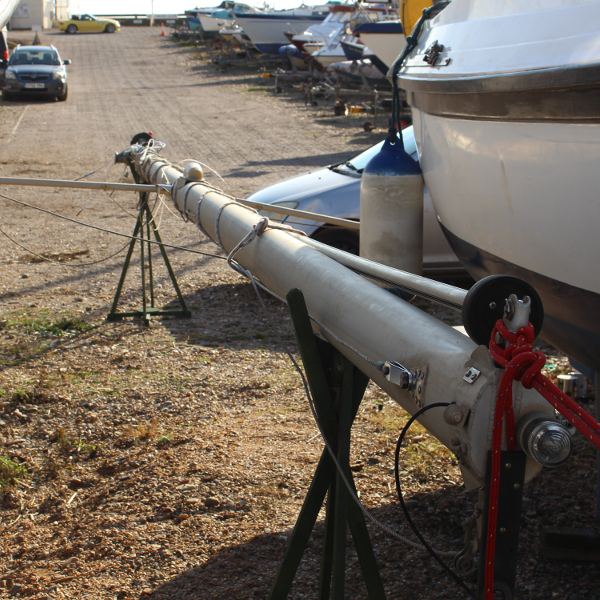
You can take confidence from the fact that there is a good deal of adjustment on the rigging screws to allow for minor measurement errors. It is worth noting that Team Jimmy Green set the turnbuckles at 2/3 open unless otherwise requested and undertake to produce the finished wires accurately to within plus or minus the diameter of the wire.
If the mast has to remain stepped, you need a slightly different approach, generally involving the purchase of each wire over-long with the top terminal swaged. The bottom end will need to be finished in situ by cutting to the exact length and fitting a DIY self-fit swageless (mechanical) terminal. Modern swageless terminals from Sta-Lok, Bluewave or Petersen are reasonably simple to fit so that you can be confident of success.
If you can take down each stay individually and temporarily to measure it accurately, you can order the replacements with swaged fittings at both ends. Each wire should be pulled out taut with some tension to ensure an accurate measurement. It won't be easy to measure a stay accurately while it is still in situ.
Please note that the information in yacht manuals should not be regarded as reliably accurate enough to make up a set of finished rigging.
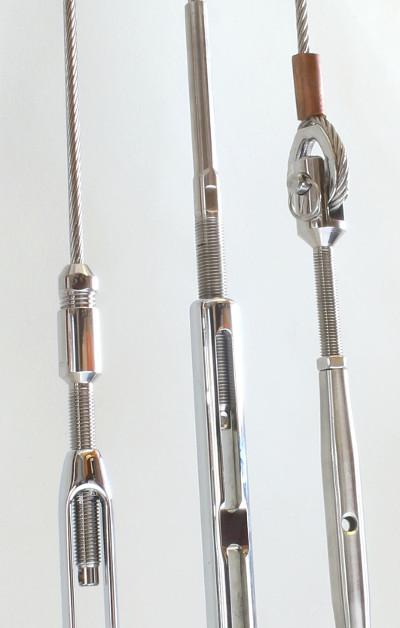
Rigging Checklist
Rig tune and tension check on existing rigging.
- Consider any design or specification alterations
- Close inspection of all components, including measuring diameters
Take photos
Mark all tension settings, determine any possible improvements.
- Order process for mast unstepped
- Order process for mast remaining stepped
Each step is explained more fully below:
Begin by checking that your current rigging is set up and tuned correctly. This need not be as technical as it sounds - you need to be sure that you will copy a rig that works well. The essentials are mast rake and bend, athwartship vertical alignment and correct tensioning. You may want to ask for some professional advice. Still, if your current setup performs satisfactorily upwind and downwind on both tacks/gybes, it may be best to avoid interfering with the current settings. The aim of the game is to replicate the old rig with a new one within parameters that allow for adjustment and tuning.
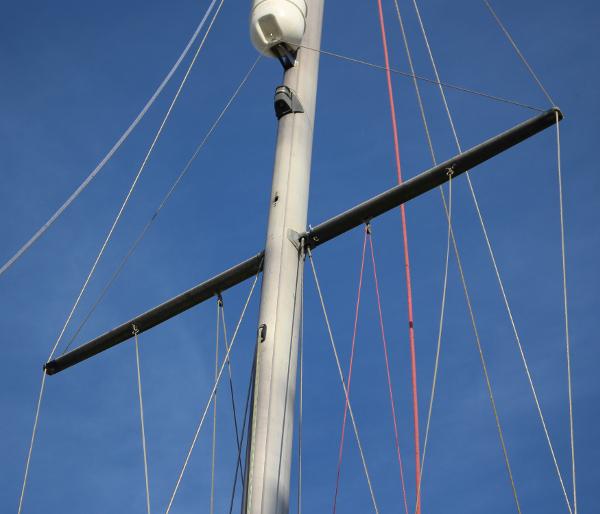
Look for extra unnecessary shackles or toggles which may have been added to compensate for the wire being too short, and determine whether they can be omitted from the new rig.
Consider any design or specification alterations.
The next step is to survey all aspects of the rigging, including an assessment of whether the existing is the right design and specification for your anticipated purposes, e.g. Coastal, Offshore or Ocean Cruising, occasional or hard core racing.
Close inspection of all components
Carry out a thorough rigging inspection, including all the wire, terminals and clevis pins. Establish the size of every component and make notes. A good quality pair of callipers is an invaluable investment for producing accurate results.
Once you have confirmed the wire diameter, the approximate length and identified the terminals, top and bottom, it is a simple online exercise to get an accurate estimate of the replacement cost on Standing Rigging . Alternatively, Team Jimmy Green can produce a costing based on the same information.
Take photos of everything, including zoomed-in details of anything you are unsure about and any others that will serve as a reminder when fitting the new shrouds and stays.
Check for any signs of wear or structural damage and identify the probable cause.
Problems can occur for many reasons:
- Misalignment leading to stress at an odd angle
- T terminals that are not seated properly in their mast plate
- T terminals that don't quite match their mast plate
- Fittings that allow unnecessary movement
- Lack of articulation due to missing toggles
- Undersized clevis pins or oversized clevis pin holes
Some of these may be the reason you are replacing the rig, so avoid repeating the issue on the new setup.
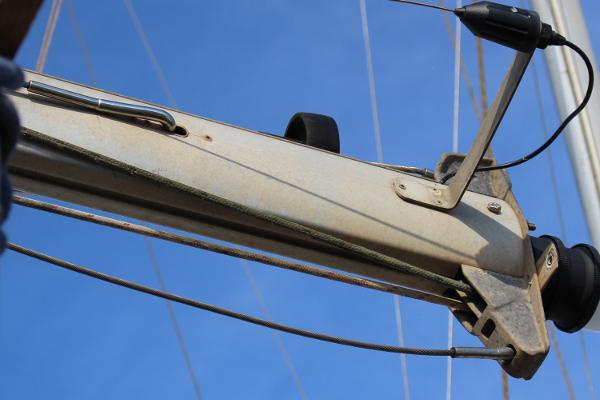
Standard pin and hole diameters correspond with the thread size of the studs in the turnbuckles. Each wire diameter has a varied choice of stud/turnbuckle sizes. Components on either side of the standard sizing are denoted as Down Size and Up Size by Petersen Stainless Rigging. Threads are generally UNF or possibly the Metric equivalent. The table below sets out all the relevant sizes for standard, Down Size and Up Size components. If your rigging has unique non-standard characteristics, the Jimmy Green Rigging Team can source bespoke replacements or suggest suitable alternatives.
This chart is a guide only. Please check all dimensions before ordering your rigging.
| Wire Diameter | Pattern | Tread UNF | Petersen Turnbuckle | Turnbuckle Toggle Pin Diameter | Petersen Eye Terminal | Eye Inside Diameter | Petersen Fork Terminal | Pin Diameter |
|---|---|---|---|---|---|---|---|---|
| 3mm | Standard only | 1/4" | GTST03 | 6mm | FSE03 | 6.35mm | SF03 | 6mm |
| 4mm | Down Size | 1/4" | GTST04DS | 6mm | ~ | ~ | ~ | 6mm |
| 4mm | Standard | 5/16" | GTST04 | 8mm | FSE04 | 8.0mm | SF04 | 8mm |
| 4mm | Up Size | 3/8" | GTST04US | 9.5mm | ~ | ~ | ~ | 9.5mm |
| 5mm | Down Size | 5/16" | GTST05DS | 8mm | ~ | ~ | ~ | ~ |
| 5mm | Standard | 3/8" | GTST05 | 9.5mm | FSE05 | 9.53mm | SF05 | 9.5mm |
| 5mm | Up Size | 7/16" | GTST05US | 11mm | ~ | ~ | ~ | ~ |
| 6mm | Down Size | 3/8" | GTST06DS | 9.5mm | FSE06 | 11.1mm | SF06 | 11mm |
| 6mm | Standard | 7/16" | GTST06 | 11mm | FSE06 | 11.1mm | SF06 | 11mm |
| 6mm | Up Size | 1/2" | GTST06US | 12.7mm | ~ | ~ | ~ | ~ |
| 7mm | Standard Only | 1/2" | GTST07 | 12.7mm | FSE07 | 12.7mm | SF07 | 12mm |
| 8mm | Down Size | 1/2" | GTST08DS | 12.7mm | FSEE08DS | 14.28mm | SF08DS | 12mm |
| 8mm | Standard | ~ | ~ | ~ | FSE08 | 14.28mm | SF08DS | 14mm |
| 8mm | Up Size | 5/8" | GTST08US | 16mm | FSE8US | 16.0mm | ~ | ~ |
| 10mm | Standard | 5/8" | GTST10 | 16mm | FSE10 | 16.0mm | SF10 | 16mm |
| 10mm | Up Size | 3/4" | GTST10US | 19mm | ~ | ~ | ~ | ~ |
| 12mm | Standard | 3/4" | GTST12 | 19mm | FSE12 | 19.05mm | SF12 | 19mm |
Please note all the turnbuckle settings before disconnecting any shrouds or stays by marking them with tape or taking photos. It would be best if you loosened all the turnbuckles to disconnect them at deck level.
Remember to return them to their noted settings before measuring. The new rigging can be made to the required length with the optimum adjustment, normally 2/3 open.
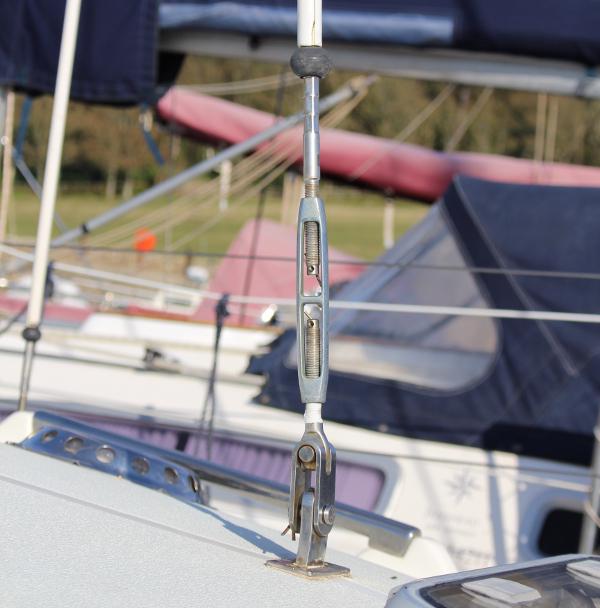
One last check to ensure that there isn’t a change of fitting or a tweak in the setup that will make the new rig an improvement on the old one.
Order Process for Mast-Unstepped.
Dependent on the time factor, there are two main options to consider:
Determine the terminals required, measure the wires, make any adjustments, place your order online, or email your requirements for Team Jimmy Green to load the order for you.
N.B. The old wires should be removed from the mast and pulled out taut with a degree of tension to ensure they are straight in readiness for measuring.
Measurements are from bearing edge to bearing edge of the pins or eyes.
Please refer to our Standing Rigging Custom Build Instructions for T terminals and studs.
Label the individual stays. You may need them as an aide memoir when you come to fit the new standing rigging.
Check and double-check your measurements and terminal fittings before ordering. Remember the old adage: “Measure twice, cut once”.
Remove the old stays, labelling them carefully and noting any amendments required to length or fittings.
Coil the wires as neatly as possible.
Send them or bring them to Jimmy Green Marine for assessment and a quote.
This option puts the onus on the Jimmy Green Rigging Team to replicate your rigging accurately.
Order Process for mast remaining stepped.
Establish the length of the existing shrouds and stays.
Please look at our Standing Rigging Custom Build Instructions
Order new wires with the required top terminals swaged on and the wire length appropriately over length for cutting and fitting in situ.
Order DIY swageless terminals for the bottom end.
The wire should be long enough to be cut and fitted with the new swageless terminal to finish at the desired length.
N.B. Replacing the forestay will be tricky if it is fitted with a headsail furler, and you may need professional help.
Take down each shroud individually. N.B. take precautions to stay the mast with a temporary line.
Measure the length accurately and replace it on the mast.
Repeat the process for each shroud or stay.
Measurements are from BEARING EDGE TO BEARING EDGE of the pins or eyes.
For T terminals and studs, refer to our STANDING RIGGING CUSTOM BUILD INSTRUCTIONS .
Jimmy Green Advisory - Check your Order Details Carefully
You must check your order confirmation for any discrepancies, especially for complex orders.
Please pay special attention to orders uploaded to our website for you, e.g. those originating from telephone or email enquiries or Team Jimmy Green pattern measurement.
This will highlight any misunderstanding before the work is commenced.
There is a wealth of information available to help you to a successful conclusion on our website:
Standing Rigging Assistance Shop for Standing Rigging
Give feedback on this article

The $tingy Sailor
Diy trailerable sailboat restoration and improvement without throwing your budget overboard.


How to Replace Your Standing Rigging for Less
When we purchased Summer Dance , the standing rigging was one system that I knew I would need to replace right away. The upper shrouds had been replaced recently with well made cables, probably from that popular online Catalina parts retailer. The backstay and forestay were in satisfactory condition but were original from 1981. The lower shrouds were a mix of mismatched, poor quality, oversized replacements and failing originals.
At first, I assumed that I would replace the backstay, forestay, and lower shrouds with kits from that same retailer. They make replacement easy with pre-made kits or they can make custom replacements from your original rigging. But their prices are steep and I’d had a bad experience with their technical support so I decided to look for other options.
Shopping around
I tried to get price quotes to compare with the Catalina parts retailer from several other rigging shops that advertise in sailing magazines and online but they were either unresponsive or vague. Next, I considered making the rigging myself from materials bought online. But investing in the proper tools would dilute the cost savings considerably. I would have to replace the rigging multiple times to recoup that investment.
Then I remembered that there is an industrial rigging company located near me. I was familiar with their regular steel wire rope products from a job that I held long ago that used their products. I called them to find out if they worked with stainless steel and if they were experienced in building sailboat rigging. Their answer to both questions was yes and they gave me a very encouraging cost per foot estimate. For about the cost of the bare wire rope to do it myself (not including tools, thimbles, and sleeves), they could do it all. That’s what I call a no-brainer.
Following are approximate costs per foot (in 2014) for standing rigging from several popular sources compared to the rigging company in my area.
Popular online Catalina parts retailer: $4.00/ft. complete West Marine: $1.02/ft. cable only McMaster-Carr: $0.85/ft. cable only Local industrial rigger: $1.13/ft. complete
I met with Cory at Broadway Industrial Supply and was surprised to learn that they fill many orders for stainless steel wire due to its popularity for architectural railings. I decided to have the shrouds made out of 316 stainless steel with thimbles and Nicro Press sleeves rather than roller-swaged terminals for two reasons: cost and simplicity.
The newer, roller-swaged style fittings are significantly more expensive than hand-pressed sleeves. The common reasons for using the new fittings are: there are fewer parts to maintain, fail, or chafe sails, and their ability to withstand a higher percentage of the breaking strength of the cable. I do admit they look really nice. Proponents make impressive claims about their superiority over the more primitive pressed sleeves. But the fact remains that pressed sleeves have been used successfully for decades in a multitude of application, are still an accepted industry practice, and even as bad as my rigging was, they performed well.
In all of the pictures in this post, the rigging tape was removed from over the swaged fittings to show their condition and workmanship.

A few words about cable types
When working with a rigger, especially an industrial rigger who may not be familiar with sailboat rigging, it’s important that you specify the correct cable type for strength, chafe avoidance, and rust resistance.
Regular steel wire rope like you can find in a home improvement or hardware store will not last long in a marine environment. Fuggedaboutit. Only stainless steel will survive and, among the different types of stainless steel cable, there are a couple of common choices. The first is 304 grade, which is slightly stronger but is less corrosion resistant or 316 grade, which is slightly less strong but more corrosion resistant. The difference between the two grades is due to the chemical composition of the metal. Your choice as to which grade to use should be made with consideration of the type of sailing you usually do (cruising or racing) and the water that you sail in (fresh or salt water).
Besides the material that the cable is made of, the construction is also important. The most common constructions that you will see are 1×19 (1 strand of 19 wires) and 7×19 (7 strands comprised of 19 wires each). The two types have different strengths, stiffness, and stretch. For applications where ease of bending and use with blocks is more important and the amount of stretch is not as important (wire to rope halyards, for example), 7×19 cable is better. In applications where minimum stretch and maximum strength are important and stiffness is not important (standing rigging, for example), 1×19 is best.

Lastly, there’s the matter of cable diameter. Your sailboat was originally equipped with cables of sufficient diameter for its design and intended use. Seldom is it beneficial to oversize the rigging diameter for racing or to endure abuse or neglect. Doing so just adds to the cost and weight aloft for negligible benefit so stick with the original diameters.
What not to do
Substandard rigging workmanship isn’t hard to spot once you’ve seen the right stuff. The cable should fit tightly around the thimbles, which should not be too small or too large for the cable diameter or the connection pin. The sleeves should be the correct size for the cable and the sleeve seam aligned perpendicular to the eye opening. Each sleeve should have the correct number of evenly spaced crimps that are appropriate for the cable diameter. Two sleeves should be pressed at each end with a space between them equal to one to two cable diameters. The cut end of the cable should extend completely through the second sleeve but not more than one cable diameter farther so as not to create frayed wires that can snag sails and skin.

The old rigging on Summer Dance was a mix of 1/8″ 1×19 wire rope (right side of the big picture) and 5/32″ 7×19 wire rope (left side of the big picture). The oversize 7×19 cables weren’t even installed in the same locations on opposite sides of the boat, which probably produced uneven loading of the mast from one side to the other.

Standard wire rope lengths
Here are the lengths of the cables for a Catalina 22 with standard rigging. All cables are 1/8” diameter, 1×19 construction.
| Forestay | 26’ – 5 ½” | 1 |
| Upper shrouds | 25’ – 3” | 2 |
| Forward lower shrouds | 12’ – 10 ¼” | 2 |
| Aft lower shrouds | 12’ – 11 ¾” | 2 |
| Non-adjustable backstay | 28’ – 2 ¼” | 1 |
| Stock adjustable split backstay | 24’ – 1 ¾” | 1 |
| Stock adjustable split backstay bridle | 4’ | 2 |
Now’s the time to customize your rigging
Shortening or lengthening your running rigging is fairly easy and most of us have done it at some time to optimize how it works. Once your standing rigging is built, however, except for significantly shortening a cable, any other changes usually require complete replacement of the part, which can be several times the cost per foot of running rigging. So when you order your standing rigging is the time to consider any length changes for things like:
- Different type of backstay (fixed or adjustable )
- Different length turnbuckles
- Extra mast rake angle
- Quick release levers
- Other modifications that can’t be accomplished with your current rigging.
Remove, replace, retune
To make it easier for Broadway Industrial Supply to build my rigging, I removed the old rigging and dropped it off with them for reference. If you do the same, label each cable so that you know where it came from. If your new rigging arrives without corresponding labels, you can at least match up the lengths with the old rigging to figure out where they go.
About a week later, I picked up the new rigging and was impressed with the quality of workmanship. All of the eyes were consistently and accurately formed. I had given my rigger a supply of white, heavy duty heat shrink tubing similar to what was on the original rigging. I asked him to put two pieces on each cable before making the eyes, enough to cover the crimped sleeves to prevent snagging and chafing the sails and running rigging. A few minutes with a heat gun sealed them all shut. Last, I slid white vinyl cable covers on the lower ends of all of the cables to prevent chafing the running rigging.
Installing the new standing rigging is simple for a trailer sailor after the mast is unstepped:
- Remove the clevis pins at each end if you haven’t already, replace the old cable with the new cable, and reinstall the clevis pins. Now is also a good time to install all new cotter pins or rings to leave no doubt as to the integrity of your connections.
- Step the mast back into position. You might need to first loosen any overly short turnbuckles.
- Tune the rigging as you normally would. I own a Loos tension gauge and its been a good investment to keep all the stays and shrouds at proper tension. For more about tuning and tension gauges, see How To Measure Standing Rigging Tensio n .
Open body vs. closed body turnbuckles
If you’ve done this job before, you might be asking, “But what about the turnbuckles, $tingy?” I chose not to replace my turnbuckles at the same time and that is reflected in my overall 70% cost savings over retail. My reasoning was not simply to save money, though. That was secondary. The biggest reason was that my existing closed body turnbuckles were still in good condition and I’m not convinced that open body turnbuckles are absolutely necessary, contrary to what many riggers will tell you in order to sell you more hardware.
I regularly disassemble, clean, inspect, and lubricate all of my turnbuckles. That alone negates the biggest reason given by the open body turnbuckle proponents. Yes, a tiny bit of water and dirt can get in those tiny holes in closed body turnbuckles. Yes, it won’t dry as fast as in an open body turnbuckle. But there’s also much less of it in there to begin with and to work its way down into the threads and corrode them compared to open body turnbuckles.
Another reason that proponents give for open body turnbuckles is that it is harder to see if a closed body turnbuckle is overextended. My rebuttal is that anybody who adequately familiarizes themselves with their closed body turnbuckles (through regular maintenance is a good way) should have no trouble recognizing whether a turnbuckle is overextended or not.
Moreover, my closed body turnbuckles are only exposed to fresh water so salt water corrosion isn’t a concern. I’ve also replaced some of the T bolts that were bent due to incorrectly rotated chain plates so those threads are new. If you’re not sure if your chain plate bolts are turned correctly, read Turn Those Chain Plate Bolts!
Open body turnbuckles are great, especially if you’re going to neglect their maintenance. If I needed to replace my turnbuckles, I’d give more consideration to open body ones. But body style alone isn’t enough reason for me to throw hundreds of dollars of working hardware away for shiny new hardware. Nuf said.
It’s now been almost ten years since I replaced by standing rigging this way and I have not had a single issue with it. And I sometimes push my rigging hard. If I ever need to do this job again, I’ll probably do it the same way.
Would you like to be notified when I publish more posts like this? Enter your email address below to subscribe to this blog and receive notifications of new posts by email. You will also receive occasional newsletters with exclusive info and deals only for subscribers and the password to the Downloads page. It’s free and you can unsubscribe at any time but almost nobody does!
Share this:
25 thoughts on “ how to replace your standing rigging for less ”.
Stingy, I really enjoy your common sense approach to boat projects, Thanks for sharing! Another thing I have seen done by cruisers on a budget is to use 2′ to 4′ of the appropriate strength galvanized chain from the chain plates to galvanized open body turn buckles that attach to the rigging. These short lengths of chain keep the extra weight down low and keep the “budget” turnbuckles up away from the elements a bit and seem to last 10 to 15 years with proper maintenance and care. Galvanized is also not prone to the “invisible” failure fractures that even good Stainless is. If you are on a budget, you can either do what works to keep moving or sit there and grow barnacles while you wait for your (money) ship to come in! Keep up the great posts!
Good advice, Warren. I can’t help but think that sailors were some of the original MacGyvers, making and fixing things with only what they had on hand and lots of ingenuity.
- Pingback: Five swing keel maintenance blunders and how to prevent them | The $tingy Sailor
Stingy, I live inland and it is difficult to source knowledge, sail rigging and assorted parts. The more detail and source info you add is appreciated tremendously and if you get some money for the link good for you. If you can edit your post to add in size of shrink wrap dia. and dia. + length of vinyl covers it would be very helpful. I was even wondering if you remembered the length of the forward shrouds after converting over to quick release system I just found a 1982 and this will be my first upgrade for money well spent. There is allot of older Catalina 22s out there in disrepair or missing parts and fewer places to ask questions. This web site is fantastic you have great ideas, thank you for taking the time to share your lessons learned and Catalina 22 knowledge.
I know what you mean. Even though we sail most often on Lake Pend Oreille where there’s a very active sailing community, we don’t live there and so can’t take advantage of their clubs to exchange knowledge. I’ll try to remember to add more detail to my posts for those who need that level of info. One of my challenges is to also make this blog general enough to be relevant to as many pocket cruisers as possible.
I believe the heat shrink tubing that I used on my standing rigging was this: 1/2 in. White Polyolefin Heat Shrink Tubing (3-Pack) . It needs to be only large enough to slip over the crimped sleeves then shrink as small as possible. That particular tubing only shrinks down to about 1/4″, so it won’t be tight around the 1/8″ shrouds but it keeps sails and lines from snagging on the thimble and sleeve edges and the wire ends. It also gives the rigging a more finished, professional look like the original rigging.
I shortened my forward lower shrouds 8-1/2″, which is close to the closed length of each quick release lever of 8-3/8″ from the bottom pin to the top-most pin position of the lever. They have two more top holes spaced 1/2″ apart that are lower that you could also use. The amount you shorten the shrouds by isn’t critical since you will leave the turnbuckle attached above the lever for fine tuning. As for the actual length of the shrouds, they should be about 12’10-1/4″ before shortening according to this diagram from the 1987 Owner’s Manual but double-check your current lengths first as there was considerable variation between boats and years.
By the way, here’s ads for two levers currently on eBay: NEW JOHNSON MARINE QUICK RELEASE HIFIELD LEVER STAINLESS SAILBOAT Hobie Shroud Extender Quick Release Hyfield Lever 1/4″ Holes 10049
Best of luck with your purchase. I hope you get a good one and we’ll see you around here as you fix her up!
Great information $tingy! One thing people may want to keep in mind, especially if they’re salt water sailers, is that the heat shrink will hold moisture at the swage and it’s virtually impossible to inspect for corrosion in that area already, even without the heat shrink. it’s a trade off one needs to conceder when building new rigging. what I do on my own boat is to leave it bare, but slip a short (12-16″) piece of 1″ pvc pipe over the lower end the the shrouds, which also covers the adjusters. moisture doesn’t collect and the cable ends, cotter pins, and other poaky things are kept away from your sails.
That’s a good point, Russ. It really is a trade-off. The tubing can help prevent water from getting into the swages in the first place but if it does, then it’s trapped there longer before it dries out. Ideally, after a five years or so in a salt water environment, we should cut the tubing off and do a closer inspection, then tape back over them.
Ironic that you should mention PVC turnbuckle boots. Watch here the day after Christmas 🙂
Where is the rigger located? In FL, by any chance??
In Spokane, WA, but there should be industrial riggers in your area. Look for one that supplies stainless steel cable for architectural hand railings, it’s the same stuff.
How did you achieve the making of the backstay with the pigtail? Did the maker create the braiding necessary to create the pigtail? e.g. Backstay, split backstay, split backstay bridle.
If you’re referring to the short pigtail attached to a single backstay that is used to hold up the boom when the mainsail is lowered, yes, the rigger made a new pigtail on the new backstay. If you’re referring to the adjustable backstay that I recently wrote about, I did not make a pigtail on that backstay. I use the topping lift instead.
I am finishing a homemade sailboat. Landlocked in Kansas. No stainless steel cables in stock, I have checked. Willing to order the 1 x 9, 1/8″ 316 cable and do the swaging myself. Planning on using eye and turnbuckle studs,at the ends of the cables as I do have turnbuckles left from another boat. These are for standing rigging. Question: can I use a swager tool bought from lowes for under $30 to get this job done on such small diameter wire?
If you’re talking about the Blue Hawk Swaging Tool model AC1058 item 348539 , then yes. That’s the same type of tool that most riggers use. There is a smaller tool that is made like a pair of dies with bolts that you tighten with a wrench to make the crimps but I’d shy away from it. Just use copper ferrules and observe the guidelines that are available only from rigging companies like Loos & Co so that you use the correct number, position, rotation, and spacing of ferrules, thimbles, and crimps.
Best of luck finishing your project! $tingy
Hi $tingy, I believe the issue that Russ mentioned regarding the extra corrosion from putting the heat shrink on the fitting isn’t so much the trapping of the moisture but the lack of oxygen to the surface of the stainless steel. Stainless can cope with moisture excellently as long as it has access to oxygen to enable it to build up a protective oxidation layer. For the same reason many riggers advise against taping up stainless fittings. Love the article though, and I’d be interested to find out what you think about Dyneema as an alternative to rigging with stainless.
Hi, Matthew
I think Dyneema is an interesting alternative and might have an advantage in some applications like high performance racing due to its very low weight aloft and the simplicity of low friction eyes instead of traditional blocks. But for the average guy cruising and club racing, it’s a novelty and he’s better off with standard parts and the wide availability products and services. I have a friend who pursued the synthetic route and by the time he was set up to make his rigging and factoring in the extra labor for splicing and pre-stretching plus the shorter lifespan of Dyneema it wasn’t any more economical.
Thanks for your question, $tingy
Great article, I am going to do exactly what you did including the addition of levers on the forward lowers and forestay. I also like the swaged eyes on both ends of the wire instead of swaged threaded stem. Do you happen t have the hole to hole measurements of the wire you had built? That would save me a bit of measuring. You mast lowering video showed me how to lower the mast single handed while the boat was on the mooring. The only hiccup I had was the mast wanted to swing from side to side when it got near the Mast-up. But no damage done.
I don’t have my exact forestay measurement handy but it’s the standard length shown in the table in the article. I didn’t modify it for a quick release lever, I simply replaced the turnbuckle with the lever and set the mast rake angle with the adjustment holes in the lever and fine tune it with my adjustable backstay.
The mast will want to swing a little from side to side when you’re raising or lowering it so just be careful for the first 45 degrees or so until the shrouds start holding it centered. If you use a 1/4″ hinge bolt in the mast step instead of the stock 5/16″ bolt, it will allow a little wiggle room without binding or bending plus it’s easier to insert and remove. That bolt never really has a load on it so strength isn’t an issue.
Check out the Dyneema! https://www.riggingdoctor.com/life-aboard/2015/8/10/synthetic-rigging-conversion We have guys in the marina with it almost two years on and zero signs of deterioration. They get remnants from cordage houses pennies on the dollar. I would have replaced with the synthetic but I was too much of a newb. No more stainless cable for me.
Hi, I’m surprised that no one has mentioned a concern about using two different metals, stainless, and copper, for these hand-pressed sleeves. In a marine environment, aren’t you guys concerned about corrosion? Worst of all, you have no way of seeing the progress of the corrosion. I’m going with the traditional rolled stainless swages or maybe even drop forged, which I just discovered here: https://www.savacable.com/Content/Images/uploaded/sava_cat.pdf (see p. 16) Thanks, Rick Owner of a Merit 25, with 3/16th head stay and back stay.
Hi, Richard
Stainless steel and copper are very close to each other on the nobility scale so they do not react to one another very much at all. Just look at the pictures in this post of the over 30-year old rigging. The sleeves are still holding strong and the wire underneath them is unaffected. Metals that are far apart from each other like stainless steel and aluminum will react to each other noticeably as I show in Beware of Galvanic Corrosion! so that’s why you would not want to use aluminum sleeves.
You mentioned using 1/8″ 1×19 wire for standing rigging. Would the running rigging for a Catalina 22 use the same diameter for 7×19 or does it need to be larger? Also, what size would you recommend for the keel-lifting cable? I didn’t see it listed in the keel maintenance article.
If you have half wire, half rope halyards and want to keep them that way, use the same diameter in 7×19. The keel lifting cable is the same diameter too. For more about replacing your standing rigging, see How to Replace Your Standing Rigging for Less . And for more about the keel lifting cable, see point #3 in Five Swing Keel Maintenance Blunders and How to Prevent Them .
Best wishes, $tingy
Interesting, I compared your lengths with the book that came with my boat and with real life lengths after a mast failure and that is what I found (totals): Forestay is 27′ 5.5″ Upper shrouds 25′ 11.75″ Forward lower shroud 13′ 6″ Aft lower shrouds 13′ 4.75″ Why? I don’t know, but I had to redo several lines (not very complicated process and cheap). Thanks for rough measurements as it allowed to arrive to some measurements.
What year is your boat? The lengths that I gave are from the owner’s manual for the pre-’86 design.
Lots of very useful information here to save money when on a limited budget without sacrificing safety
Leave a comment Cancel reply
This site uses Akismet to reduce spam. Learn how your comment data is processed .
- Already have a WordPress.com account? Log in now.
- Subscribe Subscribed
- Copy shortlink
- Report this content
- View post in Reader
- Manage subscriptions
- Collapse this bar
No products in the cart.
Sailing Ellidah is supported by our readers. Buying through our links may earn us an affiliate commission at no extra cost to you.
The Standing Rigging On A Sailboat Explained
The standing rigging on a sailboat is a system of stainless steel wires that holds the mast upright and supports the spars.
In this guide, I’ll explain the basics of a sailboat’s hardware and rigging, how it works, and why it is a fundamental and vital part of the vessel. We’ll look at the different parts of the rig, where they are located, and their function.
We will also peek at a couple of different types of rigs and their variations to determine their differences. In the end, I will explain some additional terms and answer some practical questions I often get asked.
But first off, it is essential to understand what standing rigging is and its purpose on a sailboat.
The purpose of the standing rigging
Like I said in the beginning, the standing rigging on a sailboat is a system of stainless steel wires that holds the mast upright and supports the spars. When sailing, the rig helps transfer wind forces from the sails to the boat’s structure. This is critical for maintaining the stability and performance of the vessel.
The rig can also consist of other materials, such as synthetic lines or steel rods, yet its purpose is the same. But more on that later.
Since the rig supports the mast, you’ll need to ensure that it is always in appropriate condition before taking your boat out to sea. Let me give you an example from a recent experience.
Dismasting horrors
I had a company inspect the entire rig on my sailboat while preparing for an Atlantic crossing. The rigger didn’t find any issues, but I decided to replace the rig anyway because of its unknown age. I wanted to do the job myself so I could learn how it is done correctly.
Not long after, we left Gibraltar and sailed through rough weather for eight days before arriving in Las Palmas. We were safe and sound and didn’t experience any issues. Unfortunately, several other boats arriving before us had suffered rig failures. They lost their masts and sails—a sorrowful sight but also a reminder of how vital the rigging is on a sailboat.
The most common types of rigging on a sailboat
The most commonly used rig type on modern sailing boats is the fore-and-aft Bermuda Sloop rig with one mast and just one headsail. Closely follows the Cutter rig and the Ketch rig. They all have a relatively simple rigging layout. Still, there are several variations and differences in how they are set up.
A sloop has a single mast, and the Ketch has one main mast and an additional shorter mizzen mast further aft. A Cutter rig is similar to the Bermuda Sloop with an additional cutter forestay, allowing it to fly two overlapping headsails.
You can learn more about the differences and the different types of sails they use in this guide. For now, we’ll focus on the Bermuda rig.
The difference between standing rigging and running rigging
Sometimes things can get confusing as some of our nautical terms are used for multiple items depending on the context. Let me clarify just briefly:
The rig or rigging on a sailboat is a common term for two parts:
- The standing rigging consists of wires supporting the mast on a sailboat and reinforcing the spars from the force of the sails when sailing.
- The running rigging consists of the halyards, sheets, and lines we use to hoist, lower, operate, and control the sails on a sailboat.
Check out my guide on running rigging here !
The difference between a fractional and a masthead rig
A Bermuda rig is split into two groups. The Masthead rig and the Fractional rig.
The Masthead rig has a forestay running from the bow to the top of the mast, and the spreaders point 90 degrees to the sides. A boat with a masthead rig typically carries a bigger overlapping headsail ( Genoa) and a smaller mainsail. Very typical on the Sloop, Ketch, and Cutter rigs.
A Fractional rig has forestays running from the bow to 1/4 – 1/8 from the top of the mast, and the spreaders are swept backward. A boat with a fractional rig also has the mast farther forward than a masthead rig, a bigger mainsail, and a smaller headsail, usually a Jib. Very typical on more performance-oriented sailboats.
There are exceptions in regards to the type of headsail, though. Many performance cruisers use a Genoa instead of a Jib , making the difference smaller.
Some people also fit an inner forestay, or a babystay, to allow flying a smaller staysail.
Explaining the parts and hardware of the standing rigging
The rigging on a sailing vessel relies on stays and shrouds in addition to many hardware parts to secure the mast properly. And we also have nautical terms for each of them. Since a system relies on every aspect of it to be in equally good condition, we want to familiarize ourselves with each part and understand its function.
Forestay and Backstay
The forestay is a wire that runs from the bow to the top of the mast. Some boats, like the Cutter rig, can have several additional inner forestays in different configurations.
The backstay is the wire that runs from the back of the boat to the top of the mast. Backstays have a tensioner, often hydraulic, to increase the tension when sailing upwind. Some rigs, like the Cutter, have running backstays and sometimes checkstays or runners, to support the rig.
The primary purpose of the forestay and backstay is to prevent the mast from moving fore and aft. The tensioner on the backstay also allows us to trim and tune the rig to get a better shape of the sails.
The shrouds are the wires or lines used on modern sailboats and yachts to support the mast from sideways motion.
There are usually four shrouds on each side of the vessel. They are connected to the side of the mast and run down to turnbuckles attached through toggles to the chainplates bolted on the deck.
- Cap shrouds run from the top of the mast to the deck, passing through the tips of the upper spreaders.
- Intermediate shrouds run from the lower part of the mast to the deck, passing through the lower set of spreaders.
- Lower shrouds are connected to the mast under the first spreader and run down to the deck – one fore and one aft on each side of the boat.
This configuration is called continuous rigging. We won’t go into the discontinuous rigging used on bigger boats in this guide, but if you are interested, you can read more about it here .
Shroud materials
Shrouds are usually made of 1 x 19 stainless steel wire. These wires are strong and relatively easy to install but are prone to stretch and corrosion to a certain degree. Another option is using stainless steel rods.
Rod rigging
Rod rigging has a stretch coefficient lower than wire but is more expensive and can be intricate to install. Alternatively, synthetic rigging is becoming more popular as it weighs less than wire and rods.
Synthetic rigging
Fibers like Dyneema and other aramids are lightweight and provide ultra-high tensile strength. However, they are expensive and much more vulnerable to chafing and UV damage than other options. In my opinion, they are best suited for racing and regatta-oriented sailboats.
Wire rigging
I recommend sticking to the classic 316-graded stainless steel wire rigging for cruising sailboats. It is also the most reasonable of the options. If you find yourself in trouble far from home, you are more likely to find replacement wire than another complex rigging type.
Relevant terms on sailboat rigging and hardware
The spreaders are the fins or wings that space the shrouds away from the mast. Most sailboats have at least one set, but some also have two or three. Once a vessel has more than three pairs of spreaders, we are probably talking about a big sailing yacht.
A turnbuckle is the fitting that connects the shrouds to the toggle and chainplate on the deck. These are adjustable, allowing you to tension the rig.
A chainplate is a metal plate bolted to a strong point on the deck or side of the hull. It is usually reinforced with a backing plate underneath to withstand the tension from the shrouds.
The term mast head should be distinct from the term masthead rigging. Out of context, the mast head is the top of the mast.
A toggle is a hardware fitting to connect the turnbuckles on the shrouds and the chainplate.
How tight should the standing rigging be?
It is essential to periodically check the tension of the standing rigging and make adjustments to ensure it is appropriately set. If the rig is too loose, it allows the mast to sway excessively, making the boat perform poorly.
You also risk applying a snatch load during a tack or a gybe which can damage the rig. On the other hand, if the standing rigging is too tight, it can strain the rig and the hull and lead to structural failure.
The standing rigging should be tightened enough to prevent the mast from bending sideways under any point of sail. If you can move the mast by pulling the cap shrouds by hand, the rigging is too loose and should be tensioned. Once the cap shrouds are tightened, follow up with the intermediates and finish with the lower shrouds. It is critical to tension the rig evenly on both sides.
The next you want to do is to take the boat out for a trip. Ensure that the mast isn’t bending over to the leeward side when you are sailing. A little movement in the leeward shrouds is normal, but they shouldn’t swing around. If the mast bends to the leeward side under load, the windward shrouds need to be tightened. Check the shrouds while sailing on both starboard and port tack.
Once the mast is in a column at any point of sail, your rigging should be tight and ready for action.
If you feel uncomfortable adjusting your rig, get a professional rigger to inspect and reset it.
How often should the standing rigging be replaced on a sailboat?
I asked the rigger who produced my new rig for Ellidah about how long I could expect my new rig to last, and he replied with the following:
The standing rigging should be replaced after 10 – 15 years, depending on how hard and often the boat has sailed. If it is well maintained and the vessel has sailed conservatively, it will probably last more than 20 years. However, corrosion or cracked strands indicate that the rig or parts are due for replacement regardless of age.
If you plan on doing extended offshore sailing and don’t know the age of your rig, I recommend replacing it even if it looks fine. This can be done without removing the mast from the boat while it is still in the water.
How much does it cost to replace the standing rigging?
The cost of replacing the standing rigging will vary greatly depending on the size of your boat and the location you get the job done. For my 41 feet sloop, I did most of the installation myself and paid approximately $4700 for the entire rig replacement.
Can Dyneema be used for standing rigging?
Dyneema is a durable synthetic fiber that can be used for standing rigging. Its low weight, and high tensile strength makes it especially popular amongst racers. Many cruisers also carry Dyneema onboard as spare parts for failing rigging.
How long does dyneema standing rigging last?
Dyneema rigging can outlast wire rigging if it doesn’t chafe on anything sharp. There are reports of Dyneema rigging lasting as long as 15 years, but manufacturers like Colligo claim their PVC shrink-wrapped lines should last 8 to 10 years. You can read more here .
Final words
Congratulations! By now, you should have a much better understanding of standing rigging on a sailboat. We’ve covered its purpose and its importance for performance and safety. While many types of rigs and variations exist, the hardware and concepts are often similar. Now it’s time to put your newfound knowledge into practice and set sail!
Or, if you’re not ready just yet, I recommend heading over to my following guide to learn more about running rigging on a sailboat.
Sharing is caring!
Skipper, Electrician and ROV Pilot
Robin is the founder and owner of Sailing Ellidah and has been living on his sailboat since 2019. He is currently on a journey to sail around the world and is passionate about writing his story and helpful content to inspire others who share his interest in sailing.
Very well written. Common sense layout with just enough photos and sketches. I enjoyed reading this article.
Thank you for the kind words.
Leave a Reply Cancel reply
Your email address will not be published. Required fields are marked *

Replacing standing rigging
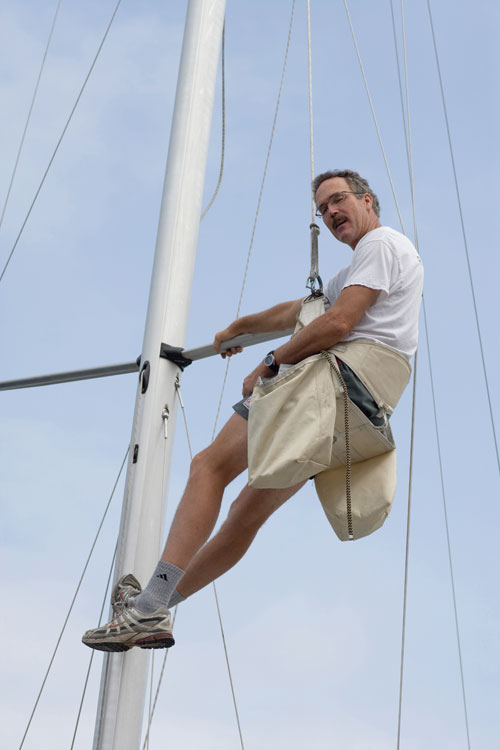
Also in Technique
- Survive going overboard
- The knots you need to know
- How to start sailing shorthanded
- Winch servicing
- Repairing delaminated core
- Splicing Dyneema
- DIY custom bug screens
- Anchoring and mooring a catamaran
- Co-owning a boat
- Installing a steering wheel
Also from Staff
- Tor Johnson
- Learn to Sail Better
- New boat: Aureus XV Absolute
- Remembering Hobie
- Catalina 275 Sport
- New boat: Saphire 27
Standing Rigging on a Sailboat: Everything You Need to Know
by Emma Sullivan | Aug 14, 2023 | Sailboat Gear and Equipment
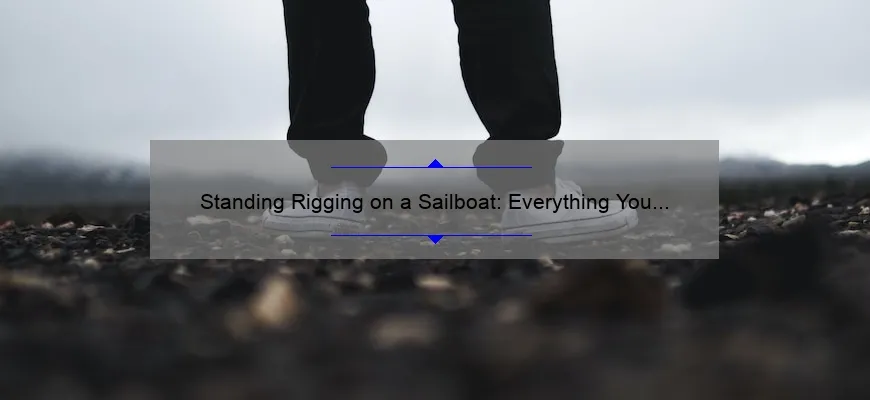
Short answer standing rigging on a sailboat:
Standing rigging on a sailboat refers to fixed lines and cables that support the mast and help control its movement. It includes components like shrouds, stays, and forestays. These essential elements ensure stability and proper sail trim while underway.
Understanding the Importance of Standing Rigging on a Sailboat
Sailboats are marvels of engineering and ingenuity, capable of harnessing the power of the wind to transport us across vast oceans and explore far-flung destinations. As sailors, we often focus on the majestic sails, sleek hull designs, and cutting-edge navigation technology that make these vessels so awe-inspiring. However, there is one crucial component that sometimes goes unnoticed but plays a vital role in keeping our sailboats safe and seaworthy – the standing rigging.
The standing rigging refers to the network of wires and cables that support the mast and allow it to bear the tremendous loads exerted by the sails. It acts as the backbone of a sailboat’s rig , providing stability, strength, and balance. Understanding its importance is crucial for anyone who sets foot on a vessel with dreams of cruising or competing.
Firstly, let’s examine why standing rigging is essential for sailboat safety. Imagine being out at sea when suddenly your mast collapses due to faulty rigging . This nightmare scenario can easily be avoided by regularly inspecting your boat’s standing rigging for signs of wear or fatigue. Frayed wires or corroded fittings could weaken the entire structure, making it susceptible to failure under heavy winds or rough seas . By ensuring your standing rigging is in good shape through routine maintenance and inspections by professionals, you can significantly reduce this risk and ensure your own safety onboard.
Moreover, properly tensioned standing rigging is vital for maintaining optimum sailing performance. The tension in each wire within the standing rig allows for efficient transfer of power from sails to keel through mast compression. If your standing rigging is too loose or too tight, it can negatively impact your sail trim and overall boat handling capabilities. A well-tuned rig will provide better control over sail shape adjustments necessary for different wind conditions while maximizing speed potential – something every sailor strives for!
Beyond safety and performance, understanding the importance of standing rigging requires recognizing its impact on the overall balance of your sailboat. The rigging plays a crucial role in maintaining the boat’s equilibrium by counteracting the forces exerted by the sails. Without proper tension and alignment of the standing rig, a sailboat may become unbalanced, resulting in compromised stability. This imbalance can make steering more challenging, increase the risk of broaching, or even lead to capsizing in extreme cases. Therefore, paying close attention to your standing rigging ensures that your boat remains stable and enjoyable to sail.
Lastly, it is worth mentioning that investing in high-quality materials and professional rigging services will prove cost-effective in the long run . While it may be tempting to cut corners or delay necessary upgrades or maintenance, neglecting your standing rigging will only result in more significant expenses down the line. Inadequate rig tension can lead to excessive wear on other components such as sails or mast fittings, increasing their replacement frequency and cost.
In conclusion, understanding and valuing the importance of standing rigging on a sailboat is essential for sailors of all levels. It directly impacts safety at sea, enhances sailing performance, maintains balance and stability, ultimately contributing to an enjoyable experience on board. So next time you set foot on a sailboat or contemplate owning one yourself, don’t forget to give due attention to this often overlooked but vital aspect – your boat’s standing rigging!
Step-by-Step Guide: How to Inspect and Maintain Standing Rigging on a Sailboat
Title: Cracking the Code: A Step-by-Step Guide to Inspecting and Maintaining Standing Rigging on a Sailboat
Introduction: Ahoy, fellow sailors! Whether you’re an experienced seafarer or a sailing enthusiast ready to cast off, understanding how to inspect and maintain your sailboat’s standing rigging is crucial for smooth voyages on the high seas. In this detailed guide, we will unravel the mysteries of standing rigging examination and upkeep, enabling you to confidently navigate through any sailing adventure. So hoist your mainsail, secure your halyards, and let’s dive into the world of rigging maintenance !
1. Understanding Standing Rigging: Before we embark on our inspection journey, let’s clarify what exactly constitutes standing rigging. Embracing technical jargon like professionals often do, this refers to those sturdy wire cables that provide support to the mast and keep everything in place as your vessel slices through the waves. These cables are under constant stress from wind pressure and oceanic forces; therefore, routine inspections are vital.
2. Assemble Your Inspection Arsenal: Essential tools at hand? Check! Embark upon your quest equipped with binoculars (to assess hard-to-reach areas), a multimeter (for electrical testing), tape measure (we love accuracy!), a notepad (to document findings), lubricant spray can (to combat rust), and some good ol’ elbow grease.
3. Visual Inspection Bonanza: Begin by examining every component of your standing rigging thoroughly. Start from bow to stern – nothing should elude your gaze! Look out for signs of fraying wires, corrosion spots – identified by those elusive green spots -, improperly tightened connections or turnbuckles hanging loose like unfortunate pirate hooks. Pay close attention when checking shrouds and stays around their terminal points.
4. Tension Testing Zen: Employing a multimeter capable of measuring tension is vital for this next step. Like tuning an instrument, each cable must be correctly tensioned to ensure optimal performance . Begin at the base of your mast, working your way up one stay or shroud after another, carefully noting the readings. Adjust tensions as needed, using the manufacturer’s guidelines as your North Star.
5. Get Into Detailing Mode: To maintain a seaworthy craft, meticulousness is key! Start by cleaning every inch of standing rigging with fresh water and mild soap to rid it of salt crystals and other corrosive agents that Mother Nature throws our way. Once dry, inspect terminals for any hidden corrosion potential. Remember to apply lubrication around all fittings where metal meets metal – preserving their longevity on this salty adventure.
6. Diving into DIY Replacements: Sometimes, despite our best efforts, some elements may need replacement eventually. Worn-out or damaged fittings demand immediate action! While there are professionals who can lend a helping hand, attempting minor repairs yourself allows you to save time and money in the long run. Just remember safety first – secure your vessel properly before venturing aloft!
7. Periodic Inspections are Pathway to Peace: As the seasons go by and maritime miles accumulate beneath your hull’s keel, remember that rigging inspections should become regular occurrences in your life as a sailor. Incorporating these tasks into your annual maintenance routine will keep you up-to-date on the health of your standing rigging and reduce unexpected surprises during those thrilling offshore adventures.
Conclusion: With this comprehensive guide in tow, inspecting and maintaining standing rigging on a sailboat will no longer bewilder even the most landlocked soul. Armed with knowledge and armed-still-with tools-of-the-trade in hand – embark upon every voyage knowing that smooth sailing is within reach! Remember comrades: vigilance coupled with clever maintenance ensures many marvelous voyages atop Neptune’s watery kingdom!
The Key Components of Standing Rigging on a Sailboat Explained
When it comes to sailing, understanding the key components of standing rigging is crucial. This system of cables and wires plays a vital role in keeping a sailboat’s mast upright and ensuring the safety of everyone on board. So, let’s dive into these essential elements to unravel their importance and how they work together seamlessly.
1. Mast: The mast, often referred to as the backbone of a sailboat, is a tall vertical structure that supports the sails. It provides stability and acts as an attachment point for various components of the standing rigging.
2. Shrouds: Shrouds are strong steel or synthetic cables that extend from the top of the mast down to its sides, creating lateral support. Usually arranged in pairs, they help prevent excessive side-to-side movement and maintain proper alignment while under sail or at anchor .
3. Forestay: Situated at the front of the mast, directly opposite to where you stand while steering, is the forestay. This forward-facing cable keeps the mast from tipping backward due to wind pressure against the sails when sailing upwind. It ensures that your sailboat remains balanced even in gusty conditions.
4. Backstay: The backstay is another essential component that counterbalances the force exerted by the forestay on your sailboat’s mast when sailing upwind or under heavy loads. Most commonly attached at or near the highest part of your boat ‘s stern (aft end), this cable prevents undue bending or breaking caused by fore-aft pressure.
5. Tangs and Turnbuckles: These small yet mighty components connect shrouds and stays to both the hull and mast with ease and allow for easy adjustment and fine-tuning of tensioning within your standing rigging system. Tangs are fittings attached directly to masts or other structural components using bolts or screws, while turnbuckles provide threaded connections allowing for precise adjustments.
6. Spreaders: Installed horizontally on either side of the mast, spreaders play a crucial role in maintaining the integrity and proper angle of shrouds. They prevent excessive bending or twisting forces by creating a wider stance for the shrouds, ensuring even stress distribution.
7. Standing Rigging Lifelines: These lines, typically made of stainless steel wires or synthetic materials like Dyneema, serve as an additional safety measure by helping to prevent crew members from falling overboard while working on deck. Strategically placed along the sides of the sailboat, they offer stability and support during maneuvering or rough seas.
Understanding these key components is vital not only for sailboat owners but also for anyone interested in sailing . Proper maintenance and routine inspections are essential to ensure optimal performance and mitigate any risks associated with deficiencies within your standing rigging system.
So next time you set sail or find yourself gazing out at a beautifully rigged sailboat, take a moment to appreciate the intricate balance and coordination that these key components provide. It’s truly a remarkable collaboration between technology, engineering, and Mother Nature herself – allowing us to glide through the waves with grace and elegance.
Common FAQs about Standing Rigging on a Sailboats Answered
Introduction: Standing rigging is an essential component of sailboats, playing a crucial role in supporting the mast and ensuring optimal performance on the water. However, many sailors are often perplexed by various aspects of standing rigging, leading to a multitude of frequently asked questions. In this comprehensive blog post, we aim to answer some of the most common FAQs about standing rigging on sailboats, providing detailed and professional insights while adding a touch of wit and cleverness.
1. What exactly is standing rigging? Ah, standing rigging – the unsung hero of every sailboat! Standing rigging refers to all the fixed elements that support the mast in an upright position. These elements typically comprise stainless steel wires called shrouds and stays along with associated fittings like turnbuckles and tangs. Think of it as the sturdy backbone that keeps your mast from taking an inconvenient swim!
2. When should I inspect my standing rigging? Regular inspections are crucial for maintaining a safe sailing experience. We recommend inspecting your standing rigging at least once a year or before embarking on any long voyage. Additionally, keep an eye out for any signs indicating potential problems such as excessive rust, wire deformation, or frayed cables. Remember: It’s better to be safe on land than sorry at sea !
3. How do I know when it’s time to replace my standing rigging? While rigorous inspections can highlight any potential issues, there are certain indicators that suggest your standing rigging might need replacement sooner than later:
a) Age: As a general rule of thumb, consider replacing your standing rigging after 10-15 years. b) Visible damage: If you spot visible signs of wear and tear like broken strands or corroded fittings, it’s time for new gear. c) Elongation: In some cases, constant strain can cause wire elongation over time – if this exceeds manufacturer recommendations or 5%, it’s replacement time. d) Performance decline: Have you noticed reduced boat performance or excessive mast movement? Outdated rigging may be the culprit.
4. Can I inspect and replace standing rigging myself? Inspecting your own standing rigging is indeed possible if you possess adequate knowledge and experience. However, replacing it yourself requires specific expertise, so unless you’re a seasoned sailor with professional background in rigging, we highly recommend entrusting this task to certified riggers who can ensure everything is done correctly. After all, your safety should never be compromised!
5. How much does standing rigging replacement cost? Ah, the golden question! While costs can vary depending on factors like the size of your boat, the material used for new rigging (stainless steel or synthetic fibers), and labor expenses – expect to invest anywhere from a few thousand to tens of thousands of dollars for a complete standing rigging replacement. Remember that proper maintenance upfront can help extend the lifespan of your rigging and save you some precious doubloons!
6. Can I switch from stainless steel to synthetic fibers for my standing rigging? Absolutely! Synthetic fiber alternatives like Dyneema® have gained popularity due to their lighter weight, high strength-to-weight ratio, and lower corrosion risk compared to stainless steel. These materials offer enhanced performance capabilities and are a valid consideration when upgrading or replacing your standing rigging system entirely.
7. What’s the typical lifespan of synthetic fiber standing rigging? While longevity depends on various factors such as usage patterns and environmental conditions, well-maintained synthetic fiber standing rigging systems generally last around 10-12 years before requiring replacement – comparable to their stainless steel counterparts.
Conclusion: Standing rigging on sailboats may seem mysterious at first glance, but by answering these common FAQs with informative yet witty explanations, we hope to shed light on this crucial sailing component while bringing a smile to our readers’ faces. Remember, understanding and properly maintaining your standing rigging will ensure safe and enjoyable voyages for years to come. So, stay rig-ready and sail on!
Upgrading Your Standing Rigging: What You Need to Know
In the world of sailing, upgrading your standing rigging is a vital decision that can greatly impact your vessel’s performance and overall safety. The standing rigging, which includes the various wires and cables that hold the mast upright, plays an essential role in ensuring stability and proper sail control. In this blog post, we will delve into everything you need to know about this crucial aspect of sailing.
Firstly, why should you consider upgrading your standing rigging? Over time, wear and tear can take a toll on this crucial component of your boat . Exposure to harsh weather conditions, continuous strain from strong winds or heavy sails, and even galvanic corrosion can all lead to the degradation of your rigging. As a responsible sailor, it is imperative to regularly assess the condition of your standing rigging and determine when an upgrade is necessary.
When it comes to upgrading your standing rigging, there are several key factors you need to consider. One essential aspect is choosing the right materials for your new rigging. Traditionally, stainless steel has been widely used due to its durability and strength. However, recent advancements in composite materials have opened up new possibilities for sailors. High-tech fibers like carbon or aramid offer impressive strength-to-weight ratios while being less susceptible to corrosion than steel.
It is important to consult with an experienced rigger or marine engineer who can guide you in selecting the most suitable material for your specific sailing activities and vessel type. They will take into account factors such as boat size, intended use (racing or cruising), budget constraints, and local climate conditions before recommending the best material for your standing rigging upgrade.
Another crucial consideration in upgrading your standing rigging is determining whether you want to switch from wire rope-based rigging to rod-based systems or composite products. Rods are known for their superior stiffness and excellent fatigue resistance but may require specialized equipment for assembly and maintenance. Composite systems typically combine carbon fiber or fiberglass with a resin matrix, offering versatility and customization options.
Furthermore, when planning to upgrade your standing rigging, it’s essential to conduct a thorough inspection of the mast and fittings. Any signs of wear and tear, cracks, or deformations in the mast or associated hardware should not be overlooked. Reinforcing these components may be necessary before installing new rigging to ensure optimal safety and performance .
During the installation process itself, meticulous attention to detail is crucial. Proper tensioning and alignment of the rigging are vital for achieving optimal sailing performance . Consulting with professionals in the field will ensure that you avoid common pitfalls such as over-tensioning or under-tensioning your rigging, which can potentially compromise its strength and longevity.
Upgrading your standing rigging not only ensures a safer sailing experience but also presents an opportunity to enhance your vessel’s performance capabilities. By optimizing sail control and reducing overall weight aloft, you can achieve faster speeds and improved maneuverability on the water.
In conclusion, upgrading your standing rigging is an investment that should never be taken lightly. It requires careful consideration of multiple factors such as materials, boat specifications, and local conditions. Seeking expert advice throughout this process will help you make informed decisions that align with your sailing goals while ensuring maximum safety and enjoyment on the open seas . So don’t hesitate – take charge of your vessel’s integrity today by embarking on an exhilarating upgrade journey!
Troubleshooting Common Issues with Standing Rigging on a Sailboat
Title: Navigating the High Seas of Standing Rigging: Deconstructing Common Sailboat Troubles
Introduction: Setting sail on a beautiful day, wind in your hair, and salt in the air – there’s nothing quite like the freedom of sailing. But as any experienced sailor knows, with great freedom comes great responsibility; one must always be prepared to tackle common issues that can arise with standing rigging on a sailboat. In this comprehensive guide, we’ll be your navigational chart through the murky waters of troubleshooting these problems.
1. The Tale of Loose Wires: Picture this: you’re out at sea, enjoying the blissful embrace of nature when suddenly you notice an unsettling amount of slack in your boat’s rigging wires. As panic sets in, take a deep breath and remember that loose wires are not an uncommon predicament. Before jumping ship into despair, consider inspecting your turnbuckles for any signs of wear or corrosion. Often, a simple tightening or lubing can solve the issue and restore equilibrium to your rigging system.
2. Strange Groans from Your Mast: As the wind howls through your sails, does it feel like someone is playing an eerie tune on your mast? Fear not! These disconcerting noises can typically be traced back to halyards rubbing against sheaves or pulleys. Be diligent about inspecting these components and ensuring they are properly aligned and lubricated.
3. The Mystery of Shaky Connections: Imagine cruising along peacefully when you notice unsettling vibrations emanating from various connections within your standing rigging system – another nuisance faced by many sailors. Remember to check bolts and fittings for tightness and wear regularly; sometimes a mere tightening can spare you from enduring an inconvenient wobble during every voyage.
4. Elusive Corrosion Castaways: While corrosion may seem like a mythical creature lurking under layers of saltwater incantations, it sadly isn’t. The corrosive effects of the marine environment can take their toll on your rigging, leading to weakened and compromised wires. To avoid this encroaching villain, regularly inspect your rigging for signs of corrosion, paying extra attention to any dissimilar metals in contact with each other. When identified early, you can tackle this issue head-on through diligent cleaning and application of protective coatings.
5. That Perplexing Sag: No one wants a saggy rig! If you notice an unacceptable amount of slack or downward curve in your wire stays or shrouds when under load, it’s time to put on your problem-solving hat. Begin by ensuring that all turnbuckles are suitably tensioned and that the mast rake is properly adjusted. A little fine-tuning may be all it takes to regain the tautness required for smooth sailing .
6. Stay Seals Against Abrasion: Do you find your stay seals battling against wear and tear? It might be time to beef up their defenses! Insulate vulnerable areas with appropriately sized rubber tubing or durable tape like self-amalgamating tape. This extra layer of protection will help prevent damage from chafing lines or abrasive surfaces.
Conclusion: As sailboat enthusiasts know, standing rigging issues can arise unexpectedly and interrupt even the most idyllic voyages at sea. By keeping these troubleshooting considerations in mind while setting sail , you’ll have a handy compass to lead you through the challenges that come with maintaining a well-maintained rig. So next time the wind whispers trouble into your ears while adrift on your beautiful vessel, fear not – armed with knowledge and wit, you’ll conquer those common issues with ease and go back to enjoying the sublime freedom provided by sailing adventures!
Recent Posts

- Sailboat Gear and Equipment
- Sailboat Lifestyle
- Sailboat Maintenance
- Sailboat Racing
- Sailboat Tips and Tricks
- Sailboat Types
- Sailing Adventures
- Sailing Destinations
- Sailing Safety
- Sailing Techniques
Attainable Adventure Cruising
The Offshore Voyaging Reference Site

- Cruising Sailboat Standing Rigging Inspection
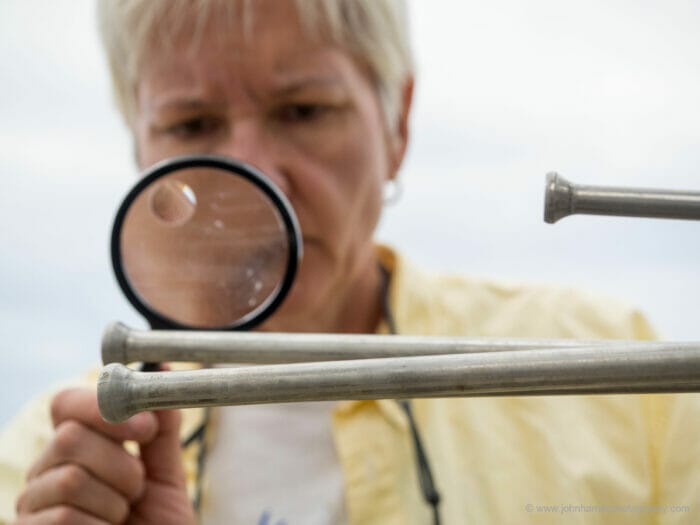
In Part 1 we got the mast out of the boat and worked for hours inspecting a bunch of stuff…and now we get to work some more.
Still, all this effort is worth it to prevent a gravity storm, so let’s carry on.
And, just so you don’t totally despair at the prospect of reading all this boring detail, don’t forget that this is leading to the much-requested rig-inspection checklist .
So grab a cup of highly caffeinated coffee and let’s do it right. Deferred gratification is good for mast karma.
Login to continue reading (scroll down)
Please Share a Link:
More Articles From Online Book: Sail Handling and Rigging Made Easy:
- Six Reasons To Leave The Cockpit Often
- Don’t Forget About The Sails
- Your Mainsail Is Your Friend
- Hoisting the Mainsail Made Easy—Simplicity in Action
- Reefs: How Many and How Deep
- Reefing Made Easy
- Reefing From The Cockpit 2.0—Thinking Things Through
- Reefing Questions and Answers
- A Dangerous Myth about Reefing
- Mainsail Handling Made Easy with Lazyjacks
- Topping Lift Tips and a Hack
- 12 Reasons The Cutter Is A Great Offshore Voyaging Rig
- Cutter Rig—Should You Buy or Convert?
- Cutter Rig—Optimizing and/or Converting
- Cruising Rigs—Sloop, Cutter, or Solent?
- Sailboat Deck Layouts
- The Case For Roller-Furling Headsails
- The Case For Hank On Headsails
- UV Protection For Roller Furling Sails
- In-Mast, In-Boom, or Slab Reefing—Convenience and Reliability
- In-Mast, In-Boom, or Slab Reefing —Performance, Cost and Safety
- Making Life Easier—Roller Reefing/Furling
- Making Life Easier—Storm Jib
- Swept-Back Spreaders—We Just Don’t Get It!
- Q&A: Staysail Stay: Roller Furling And Fixed Vs Hanks And Removable
- Rigid Vangs
- Rigging a Proper Preventer, Part 1
- Amidships “Preventers”—A Bad Idea That Can Kill
- Rigging a Proper Preventer—Part 2
- Downwind Sailing, Tips and Tricks
- Downwind Sailing—Poling Out The Jib
- Setting and Striking a Spinnaker Made Easy and Safe
- Ten Tips To Fix Weather Helm
- Running Rigging Recommendations—Part 1
- Running Rigging Recommendations—Part 2
- Two Dangerous Rigging Mistakes
- Rig Tuning, Part 1—Preparation
- Rig Tuning, Part 2—Understanding Rake and Bend
- Rig Tuning, Part 3—6 Steps to a Great Tune
- Rig Tuning, Part 4—Mast Blocking, Stay Tension, and Spreaders
- Rig Tuning, Part 5—Sailing Tune
- 12 Great Rigging Hacks
- 9 Tips To Make Unstepping a Sailboat Mast Easier
- Cruising Sailboat Spar Inspection
- Cruising Sailboat Running Rigging Inspection
- Cruising Sailboat Rig Wiring and Lighting Inspection
- Cruising Sailboat Roller Furler and Track Inspection
- Download Cruising Sailboat Rig Checklist
Hi John, A very nice series of articles. A few thoughts: There are (perhaps were at this time) rod rigging maintenance books that did not mention a dab of grease on the cold molded heads prior to re-assembly My rigger, now retired, said rod should be replaced every 100,000nm, but he said it depended on the size of the rod. It has been a while, but I remember larger rod needed to be replaced sooner than the rod on smaller boats. I would be curious about whether that can be confirmed. In Europe, I had a required periodic insurance survey which mentioned replacement of wire rigging every 8 years and rod at 10 years. I tried to challenge that and failed: in part as I was told all surveyors in the UK and EU adhered to that schedule. Mileage did not matter. In a number of my overwintering yards, over the years, I have had to leave the mast up. I always pressured up the backstay adjuster a bit and firmed up the running backstays to keep the rig from movement. I am always surprised when 6 months later everything is as I left it. (Having pressure on the backstay adjuster also keeps the adjuster from “breathing” as the atmospheric pressure changes which saves wear on the seals- I never leave it completely slack even at anchor). If it fails, there is a default position for my backstay adjuster that is basically full slack. I tried to tension the rig by bringing the turnbuckle to its most closed position and the backstay was not nearly tensioned enough when it was full slack. I had a pair of “tangs” made that were a few inches shorter than the default length of the adjuster. This allowed me to replace the whole adjuster with the tangs and get good tension on the backstay, albeit not adjustable. I was living aboard full-time and this was nice as well because I could continue to sail while the adjuster was off the boat for servicing, which often took a while if needing to be sent off. I wanted to consider DIY Dyform rigging when I re-rigged in the UK, but was told that Dyform was the name of the wire made in the UK, but that the company had stopped making it as they could not compete with the compacted wire coming out of Asia. I attempted to explore the province of the compacted wire I could find, but that was too confusing. Riggers I consulted and were working with were wary, so I went with rod. This was 10+ years ago, so please check it out. One rigger I know and some experienced sailors say that a rig that has been to sea in a hurricane should have the rigging made new. Same advice for a really hard grounding. In other words, some shock loading and abuse can be cause for re-rigging. My best, Dick Stevenson, s/v Alchemy
All good information. The big take aways for me are that no one really knows what the right replacement periods are, and further we have to guard against those expressing opinions that are more about serving their own interests than based on any real facts. I know of one rigger that states on their site that all rod should be replaced every six years, clearly more about commercial gain than anything else.
As to getting longer than ten years out of Rod, I was offered that at 12 years in 2019 by Pantaenius UK as long as I had the heads NDT tested, so I think that is a valid option, although, as always, it depends on the underwriter you end up talking to.
Can’t really see how the size of the rod would make a difference to required replacement time. I would think that would be more about the safety margins the designer had built into the rod sizing than anything else.
Although it is only of interest to a minuscule number of AAC readers, you are correct in noting that wooden boats, or at least plank on frame ones, cannot stand having their rig set up so hard that the lee shrouds do not go slack when hard on the wind. The traditional structure is simply not rigid enough although a modern wood/epoxy composite boat may be. The resulting flapping around is no doubt hard on the gear, but not as destructive as over stressing the structure would be. I wonder about the rigidity of some fibreglass boats as well, having sailed aboard some that did a lot of creaking and groaning in rough weather.
Another “advantage” of a wooden boat with a wooden mast is that the mast needs varnish every year. This is infinitely easier to do when it is horizontal rather than vertical and a lot easier when all of the standing and running rigging is removed. So, I unstep the mast and strip the gear every year which forces a close inspection of everything.
I have always had the notion that bronze turnbuckles, toggles and related hardware are not as subject to fatigue failure as stainless, but perhaps that is incorrect.
As you might of guessed, I put in that exception based on education from the horribly overpaid AAC wooden boat consultant…you.
Certainly makes sense since plank on frame wood will, in my limited experence, tend to permanently change shape over time if in any way over loaded. I’m thinking about wooden boats that hog over time, when I say that.
I wonder if this is a function of plank on frame not being a homogenous material, so that over loading changes the relationship between the planks and frames—slippage if you will.
And extrapolating from that maybe that’s why fibreglass boats, if properly constructed, are happy enough to have the lee shrouds tight without permanent damage.
A key point in all of this is that (counterintuitively) having the lee shrouds just firm when going to windward does not increase the maximum load on rig or hull when underway. Said load is governed by the maximum stability of the boat.
However, said no-slack tune, does increase the load on the hull when the boat is at rest, so I’m thinking that may be the problem.
A good discussion of that here: https://loosnaples.com/how-tos/tension-gauges/
And yes, as far as I know, bronze does not have the deterioration issues of stainless steel.
This all seems very reasonable. At the same time, it is very frustrating to me that we throw away huge amounts of rigging that is still in perfectly fine shape by coming up with a conservative time and miles based approach. In truth, conservatively sized rigging that has been well looked after and not damaged could go indefinitely. Unfortunately, I don’t know how you would practically implement this as conservatively sized would need to be quantified for each design and then you would need to make sure that it was always in good shape and never had any bad loading (forestays are subject to not nice loads so I would still replace them). And your engineer is spot on that little knicks on the surface are a really big deal in any highly loaded structure. So all in, I think your recommendation is about right.
One technique that I find very helpful when inspecting wire is to simply run your hand around it while it has a preload on it and make sure it is still round, if it feels lumpy at all, you have a problem. I do this around any areas that could be higher stress such as at the exits of fittings and around spreader tips. This is in no way a substitution for a more detailed check but it is something that you can check very quickly on a quick deck walk or whenever up the rig. I am going to have to try the trick of a phone for a magnifying glass, it will certainly be more stylish than the magnifying visor I use.
Regarding wire quality, it is definitely an issue and it is actually an issue with most materials now. The more reputable suppliers are likely to include a material cert and/or a certificate of conformance with each reel of wire without even being asked. Asking your rigger is not a bad idea although I suspect not all will be able to produce one even if they originally received it. I have gotten a copy with each set of wire that I have bought. One thing that I think is probably equally important is if you are having a rigger do a swage, ask for proof of calibration on the swaging machine. The dies in these wear and other things can get out and then you may have a swage that looks good but won’t hold well. I can think of 2 riggers who told me that they haven’t had any issues so they couldn’t see why it would be checked and on one of them, I looked at a terminal in their shop and could see it was no good but they were very busy making ends for people.
Great comment, full of great tips, thank you. I will include them in the final check list and then update these in depth articles with them.
To that end, three follow up questions:
- Could you elaborate a bit on checking for out of round by feel. I’m having trouble visualizing how I could feel an inconsistency, particularly in small diameter wire, that would not be gross enough to jump out at me visually.
- Do you know anything about the process of calibrating a swaging machine, and who would do that?
- What was it you saw on the swage that was “no good” that tipped you off that the machine was out of calibration?
Regarding feeling the wire to see if it is out of round, it just feels a tiny bit lumpy to me. If you take a 50′ long shroud, each individual strand is significantly longer, like maybe 60′. Winding around each other is what makes the end product only 50′. If you have a broken strand, the rest of the strands are trying to make a straighter line which is a lower energy state so they will pull in and force the loose strand out a bit as it is no longer held in by tension. It is subtle but you can feel it. I have felt it a few times including on a boat I was about to deliver, my parents daysailor and some club boats at a club my wife used to belong to so we could sail weeknights too. In all cases that I can remember, the broken strand had broken just inside the swage fitting so a visual inspection would not have caught it right away and we really had to look and sometimes cut to find it. I don’t know the incidence rate of breaking just inside the fitting versus just outside and it may be that there are many more failures outside but those are more easily caught. Regardless, if a strand is fully broken and there is tension on the wire, it will feel out of round in that area.
I am not totally sure what the calibration process is for these machines but I am aware of a few things that are done to check or calibrate. There are a series of MIL standards (MS51844E for example) for this stuff that I believe most people will use but there may be other standards I am not aware of. The most basic check is measuring the OD of a swaged fitting which can be done with a micrometer or calipers. This is actually something that can be done on every fitting and given how quick it is, may make sense as a customer. You can find charts of the acceptable range pretty easily, here is an example from Hayn: https://hayn.com/swage-specifications/
I would hope at the very least that any rigger has a go/no-go gauge and is checking the fittings but I am not confident that actually happens. You can also do a pull test of a few samples. There are many calibration services out there that handle all sorts of different tools and machinery and it is very common for people with equipment to have a calibration contract with them. There are generally 2 types of services, one where they actually perform a calibration and adjust or replace components as needed or one where they simply provide a measurement of where you are in your calibration range and then it is your responsibility to get service if needed. In truth, a lot of the calibration checks can be done yourself but you don’t get to claim that a professional calibration service did it so it depends on what you need. The real question is what you do if you measure and find you are out of calibration. Typically, that would mean you would need to check all samples since the last calibration that passed which is part of the reason why you try to make sure to never fail by doing preventative maintenance and regular calibration checks. Having said all this, it may be that you should either plan to measure and visually inspect the fittings upon receipt or you should be certain that your rigger is using a go/no-go (that is isn’t worn, these actually typically get calibration checked too) or measuring.
What you will see for poor swages depends a bit on the machine used, I think that by far the most common will be roller but there is some rotary going on in the marine world too. As Colin mentioned, some fittings can come out of straight. I don’t actually know at what point a fitting would fail but if I could visually see this, I wouldn’t want it unless the fitting manufacturer had a spec for acceptable that it was within. In the case that I could see, the fittings were noticeably not round either due to the dies being too worn or the shafts being out of parallel but I don’t think any number of passes (2 is usually the recommended and the max is like 3-4) would have fixed it. I also strongly suspect that a basic caliper measurement would show that the fittings had not been fully compressed but I didn’t need to go that far to know to walk away.
That’s great, thanks. As soon as you pointed out that a lump would appear to indicate a broken strand inside a swage, I got it. I will definitely add that to the check list and the above.
Also, thanks for the fill on checking swages, I will add that too.
Eric. What are your thought on checking the head diameters with a mic or caliper ( don’t like these as much, not as accurate) when the mast is out? Would there be apossibility of wear or deformation of the heads on older rigging? I had a surveyor tell me that the rig was too tight on The CS 30 that I bought last year. I am wondering if this constitutes the abuse that John mentioned? Thank you.
Colin Post CS 30 Top Hat
These are not measurements that should change over time, they tell you if the original swaging job was done properly. The outside diameters of swage fittings are not subject to wear and if there has been plastic deformation, that is a problem and you want to know it and condemn the fitting. Good calipers are fine for this, the tolerance band is reasonably wide but using a mic certainly doesn’t hurt and can help if you are right on the edge of the band.
How did your surveyor determine that the rig was overtensioned? Did they use a gauge? Did you sail the boat in 20 knots of wind and look at lee shrouds? Was the mast step deformed? Very few people will just be able to pull on the rig at the dock and do the mental calculation of the wire diameter, the span, etc and make an accurate determination. My limited experience with surveyors unfortunately suggests that you should be suspicious of statements like this from them. Still, it suggests you should carefully go through everything much like John has had to do with his new boat.
I would agree with Eric’s concerns about the surveyor’s assessment since it’s difficult for me to understand how he arrived at it in any sort of reliable way. It’s actually pretty difficult to over tension the rig on most production boats as the boat will bend long before the safety margins on the wire is exceeded.
Not all insurers are adamant about replacement of rigging at 8 or 10 years, so it’s worth asking them. As our rig was in perfectly good condition at ten years I asked our insurer if they would accept a rig inspection by a professional. They did, he did an excellent and through job and they extended our cover for two years. I’m in total agreement that rigging is not an area to skimp at all. Eric’s comment about bad quality swages due to worn and/or deformed swages is absolutely right. I’ve seen new swages that were bent or creased on a number of occasions and that’s just asking for trouble.
That’s good to hear. I remember you getting that done here in Nova Scotia. I will add that too.
Interesting discussion. My take on the considerable rig on Tanielle is to use SAF 2205 duplex stainless steel in rod form. I will machine end fittings from the same material and weld them to the rod. This ss is the same strength as Nitronic 50 but has far superior fatigue properties. My caps would require 26mm 316 but only 20mm 2205 rod saving weight and windage. So far the majority of mast manufacturers end communication once this is suggested so I imagine it will be impossible to insure the rig. I would see this rig lasting a very long time and probably never needing to be replaced. Of course it would still need inspecting and there will be galvanic issues with aluminium, eg foils and masts. An australian company Arcus Wire has the Hamma range of 2205 wire which I suspect is Indian. My next step will be to ask AE Smith the NZ rig engineer who did all the rig and mast calculations for Hoek design on Tanielle, to look at the 2205 issues and benefits.
Hi William, Your suggestions seem interesting. I’m not very competent on metals, but have noticed the benefits of duplex stainless. My question here wound be the welds. Wouldn’t they disrupt the uniform strength of the rod? The superior strength and corrosion resistance of duplex is usually explained by its tighter bidirectional crystalline structure. The welding process would leave a transition zone where the cold formed rod material goes from welded to not welded. I’d assume the crystalline structure would be left not homogenous, which would seem to be a weak spot? Even if this isn’t the case, I’d be wary of the transition from the thin rod to the larger terminal. Just the change in dimensions might make a focus point for loads…? All this is just questions, curiosity, not my opinions.
Since you seem positive to exotic materials and performance, a carbon mast would solve the corrosion problem, while simultaneously saving a lot of weight and being far stronger. While I’m at it: Using Dyneema for the standing rigging will also save a lot of weight, and money, and is easy to inspect and replace, which on the other hand must be done far more often. It will also be thicker than rod, but about the same as ordinary wire, so more drag in the air than rod. In my opinion, Dyneema is the only smart solution for a cruising multihull, due to the wide platform and rig configurations, while on a cruising monohull, I don’t think so. The high end racers use high modulus carbon rod these days. I’d never suggest that for a cruiser, but it does give minimum drag and max stiffness.
This is way past my pay grade, but your question about welding jumped into my mind too.
Hi William,
That’s interesting. That said, although I’m in no way qualified to evaluate your idea, my general recommendation for cruisers is to stay away from pioneering new technologies: https://www.morganscloud.com/2013/10/25/want-to-get-out-cruising-dont-be-a-pioneer/
Apologies if this is all obvious to you, I am not sure what you have studied in this regard. The old rule of thumb is that the higher strength an alloy is, the harder it is to attach to it. I have experience with Duplex 2205 but never with welding it and I would share some concerns voiced here about that unless there was a lot of tightly controlled post processing. Not only does welding affect the crystal structure, it leaves a prestress and leaves geometries that have stress concentrations if not processed right.
Most techniques of attachment like cut threads remove material and creates stress concentrations which decrease strength which is not good. There are some forming techniques such as used in heading rod, rolling threads, etc that build up material but these create geometric stress concentrations unless spread over an enormous area so that all changes are incredibly gradual.
There are some cool tricks that you can play to deal with a lot of this but I think applying them to rigging would get quite exotic and you should be looking to carbon or PBO or whatever first. For example, in fatigue applications engineers will sometimes spec things like shot peening, laser peening, cryogenic treating, etc but these all require process development and would require you to put a lot of different vendors together. I have spec’ed all the processes I listed at some point but they were always highly specialized applications where there would be lots of testing and we were willing to pay a lot for the performance needed.
Hi Stein, John and Eric, Welding duplex gives 100% strength. Tanielle is a 24m ketch built entirely from duplex. We got welding tips from the duplex supplier then did our own destructive tests It took 3 attempts with a 100 ton brake press to break a 30mm x 6mm piece joined by welding. The break was in the HAZ zone. The 2 welders were then certified by Lloyds as was the steel and welding wire. The yacht welds were also xrayed. In welding the rodto the forks I would drill a hole in the fork , then cut slots so the welds are in shear. The weld around the top would only be for appearance and to avoid a crevice. The fork would be machined from a solid bar. 2205 comes in differrent flavours and granular structures and my flavour is SAF 2205 which has a much finer granular structure and increased strength even before heat treatment. All up we used 38 kilometers of welding wire so can probably claim a little experience. One of the welders was a retired welding teacher. http://www.tanielle.com.au
Hi William, That’s one impressive boat!!! It also seems like you have, to put it mildly, done your due diligence on this material, and on a lot of other relevant topics. My only gripe is that it seems a pity to hide that material behind paint. I know it’s not realistic or smart to have a polished stainless steel hull, but what a vision that would have been! Thanks for sharing and congratulations with the boat!
Interesting, I will have to look into welding duplex more at some point. You have quite the impressive project there, I think you must have posted a picture or a link in the past as I have a vague recollection of this. I can now see more of what your thinking is. It would be interesting to look at different options and see the best way to reduce weight aloft such as going to a carbon fiber mast or synthetic rigging or duplex rigging or whatever else there may be.
Ignoring weld strength for a minute, if I understand what you are proposing, you still are introducing a pretty significant stress due to geometry. Do you have a plan for how to deal with this? Any change in diameter or shape is a stress concentration including a change to a larger diameter and in this case it means tension in the surface of the material which is the worst if you want to discuss fatigue. The concentration is due to the stiffness of the bigger diameter being greater and being at a greater radius so if you draw your stress lines, they really concentrate around the step as they try to transfer load out. Rod fittings are a decent example of about as practical a mitigation to this as is reasonable, the shape of the end is designed to give a nice large fillet and the mating fitting puts compressive stress on it that also helps but still it is the site where you will have issues.
I am guessing that the rod doesn’t have good enough tolerances and is too difficult to post machine to allow you to do a shrink fit to it? The advantage of that is you can make a very gradually tapered socket to shrink fit on so the stress concentration is much less pronounced. I have never seen a shrunk fit fitting on rigging but most rigging is small enough in diameter that you would need very tight tolerances and a large temperature differential for it to work whereas yours is big enough that it starts to work a lot better although I suspect the tolerances are still prohibitive.
Hi Eric, Thanks for your kind words. I had in mind discontinuous V1 so the lower could heavier and allow for welding a custom fork tapered to the top. Alternatively the rod itself could be threaded. Each of the higher segments would also be oversize although reducing in diameter as we went higher. Of course this all needs designing and finite element analysis. I once had a rudder that was a shrink fit and Tanielle has 4 taper locks to connect the quadrant and ram arms to its 110mm stock. I don`t think I would be comfortable with either method on rigging. Perhaps a shrink fit combined with a swage press could work and could be worth experimenting with to determine breaking load and repeat consistency. While I take your point on fatigue and stress concentrations the safe option is simply to overbuild. The existing rig design (see website) has the V1 as 115 Nitronic 22.2mm 48t UTS , V2 as 01 Nitronic 19.5MM 36.5 UTS V3 19mm Dyform. I woud up the V1 to 25.4mm Duplex V2 to 20mm Duplex and the Dyform to Duplex wire. My intention here is to elicit the wisdom of the group and get the sort of feedback you have so kindly provided
Do you believe your rule of “no loose lee shrouds …/… ” should be applied as well for catamarans?
My assumption is that catamarans have more structural “flexibility” on the lateral axis, compared to the lateral “stiffness” of single hulls, due to the structure holding the two hulls together, and hence may justify tuning with loose lee shrouds in heavy wind, without correlatively flapping lose during winter periods.
Thank you in advance.
Full rule: “ This is why all boats, with the possible exception of wooden ones, should be tuned so that the lee shrouds are not loose when hard on the wind and fully loaded—applies to wire standing rigging, too”
Hi Patrick, As I have many decades of multihull experience, including professional racing in the Formula classes, plus designing and building boats, I can say; no, that rule does not entirely apply to multihulls. I’m fairly certain that John also agrees about this and just forgot to mention it.
Most (not all) multihulls are indeed far more flexible, meaning that it’s often not possible to remove all slack. In most cases it’s just the leeward top shroud that is slack, and it’s not on a spreader. (Diamond stays should never be slack.) The much wider base means that the shroud angle is far better, meaning that the mast doesn’t get too much play, even with a lot of slack under load. I prefer to tension it as much as possible. At least make sure it’s never slack when not sailing. If tightening hard, be sure to know the structure of that specific boat.
The trouble with Lagoon 45 that has become very public lately, via Parlay Revival on YouTube, is a good example of too tight for a poorly made structure. Lagoon is by no means the only manufacturer with this build method and weaknesses. Most “budget” production boats, also monos, have the same problems to some extent. Wood is beautiful, strong and cheap, but it rots in water. For some “strange” reason wood inside boat structures tends to get wet. Why builders can’t grasp this and why they keep using wood for structural pieces is a mystery to me… (Nope. That’s just irony. Google “planned obsolence” or “The light bulb conspiracy.”)
The performance will not suffer much from this slack, since the fore and aft rig tension is what matters and that should indeed be properly tight. If you have a cat with no backstay or such, it’s a good idea to set the main halyard aft when not sailing. Tension it well to keep the headstay and the rest tight. I also usually put ropes across the head stay or wound in a spiral around the sail, to reduce oscillation in strong wind.
Even though wooden boats and multihulls often need the shrouds and perhaps more to not be entirely tight all the time, that doesn’t mean they have less of the problems other boats have when a slack rig piece is vibrating. It just means that we need to be more vigilant in our maintenance.
Hi Patrick,
I would go along with Stein’s answer, particularly since he has way more experience with multihulls than I do.
I would also change the rule around: if we have a boat on which we can’t keep the lee shrouds firm, then we should not fit said boat with rod rigging.
Hi John, You mention disassembly of compression cone terminals. I tried to do that on 2 occasions. The first was when I wanted to replace a bent segment of my roller furling profile and the second when I replaced the cap shrouds. In all cases it turned out to be impossible, at least to me, to disassemble the terminal with any hope of reusing the wire it was attached to. Of course no problem with the cap shrouds, they had to go anyway, but annoying in the case of the headstay inside the furling extrusion: The only way to disassemble the terminal, (pushing the terminal’s body away from the wedged up wire) was to cut the wire one or two inches from the terminal, and hammering down on the protruding wire with brute force. That did the trick finally. Not even fixating the wire in a vise and hammering on the lower end of the terminal – with a wooden block for protection – was enough to make the terminal body budge. Not to mention that the vise probably did the wire no good. Of course it’s possible to unscrew the eye or fork, is that what you mean by disassembly ? My conclusion is: never fiddle with a Norseman terminal unless you want to replace (or shorten) the wire. Besides, it seems impossible to get hold of new cones as Norsemans are no longer made. But there are other brands of course. Do you or anybody else know a way to disassemble a Norseman without destroying part of the wire ?
I have taken a Stayloc apart successfully, but it was on flexible wire (steering cable) not 1×19, so not the same thing at all, and probably not as highly loaded, and that was a struggle, so I think you are right and will make a note of that in the above when I edit it to add everyone’s wisdom.
Hi John, I just found mention of the “disassembly for inspection” here:
https://www.practical-sailor.com/sails-rigging-deckgear/hidden-causes-of-rig-failure
and that makes it clear to me that by disassembly really is meant to unscrew eye or fork or whatever fitting there is from the terminal’s body and have a good look at the dead end of the wire. It could be called “opening” rather than disassembly. And of course it makes sense as the bad stuff seems to be happening where you can see it after having the terminal opened. But the threads have to be locked anew.
As an aside: Tylaska makes the cones for the Norseman fittings. They seem to have all sizes in stock. I needed new ones mainly for the expensive backstay isolators. As I have 2 independent backstays I decided to live with the old isolators although I replaced the wire.
That’s a good point. That said, I was under the impression, but could easily be wrong, that once we back off the thread on the eye, we are supposed to replace the cone before putting it back together. If that’s true, we will be starting again, and almost certainly cutting the wire.
I googled around a bit, but could not find a definitive answer on that. Does anyone know for sure?
Hi John, I just replaced my lower shrouds and the backstays with new wire. The backstays had (and have) Norsemans on their lower ends and there are these isolators with 2 each Norsemans. So I gained some experience with this type of compression cone fittings. I see no reason to replace the cone if the terminal is just opened (unscrewed) for inspection as the cone is not affected by this operation. Getting the threads cleaned enough for a proper redo of the loctite treatment could be a problem though. I didn’t have this problem as I replaced the wire anyway and so had good access to the threads. I found a good way to get the terminal off the wire in the process: cut the wire directly at the terminal and back out the cone with the wedged up wire out of the terminal’s body with a suitable punch, that way losing only an Inch or so of wire. This short length can in many cases be compensated for with the turnbuckle. Also I wondered at first why the cone has to be replaced at all, but once you have the wedged up wire in hand it becomes very clear that the cone is compressed on the wire’s core so much that you’re just not going to get if off undamaged. Bottom line: if not sure about the terminal then the best way is to check if the turnbuckle allows for some shortening of the wire and if so, cut and disassemble the terminal and redo with a new cone. One could also add a toggle to make up for the lost length if necessary, although not quite so elegant.
A good analysis that makes very good sense to me. Thank you. Also, thanks for the tip on getting the cone off with minimum wire loss.
I do still wonder if there is some reason that the cone should be replaced after just unscrewing the fitting for inspection, but I have to admit I can’t put a logical reason together to support that. What I should do is call say StayLoc and ask them, but right now I’m so busy with stuff I have promised that I’m scared to add something else to the list!
I watched one rig come down. Fortunately, it was inshore and was a rotating mast, so it lifted off the socket and the mast was undamaged. We helped them collect the pieces and towed them in. No one was hurt.
The cause? A bent toggle fractured. I had two of those crack on my Stiletto 2 (both in what you marked as the “danger area”) but I caught both during one of my regular walk-arounds (not the spring inspection–they were fine then). Ever since, I make a point of looking at them every few months.
Thanks, John! You say above “…because we discovered that she had been stored over at least one winter, and probably two, with the mast in—never a good idea, in my view…” I winter my boat in Rhode Island, and it seems 95%+ of owners leave the mast up. I’ve been taking mine down each winter, and storing it indoors. But I feel like the oddball. Would you please elaborate on this.
Thanks! Anthony
Hi Anthony,
Good on you. You are not an “oddball”. https://www.morganscloud.com/2014/11/01/the-dangers-of-storing-with-the-mast-stepped/
Added to the reasons I list in the above article, leaving the mast in add significantly to the wear and tear on all components of the rig due to constant vibration over the winters.
Hi Anthony and John, That said, and I agree, but most of the mast damage I have seen over the years has been on the unstepping and stepping of the mast and its storage (and wallet damage). I suspect the breaking point is closer to taking the mast out, but may be dependent on the skipper being present when the work is done: for example, I have watched turnbuckles dragged in the gravel/dirt on masts when no owner was present, but the crew was far more careful when I was there lending a hand and being involved. My best, Dick Stevenson, s/v Alchemy
I agree on being there when the mast is unstepped, or stepped. Some tips on that here: https://www.morganscloud.com/2014/12/06/9-tips-to-make-unstepping-your-mast-easier/
Hi. What to use for lubrication of the turnbuckles? A Google search yields so many contradicting recommendations. I have used Lewmar winch grease (which is a calcium grease, and which is supposed to be VERY good), but Selden makes a rigging OIL that they recommend using (twice a year). Other say to use a molybdenum grease, and I even see some recommend Mc Lube SailKote.
Thanks, Arne.
Hi Arne, I hav used anhydrous lanolin for decades and been very happy. Lasts for a whole season or longer. I will be interested in what others use. My best, Dick Stevenson, sv Alchemy
I use my favourite Lubriplate, as I do for most everything on the boat. 130 AA https://www.lubriplate.com/Products/Grease/Multi-Purpose-Greases/130-Series/NO-130-AA
The Logbook
The captain's notebook, first mate's journal, ports of call, the book locker, photography by laura, cruising lealea on youtube.
| |
|

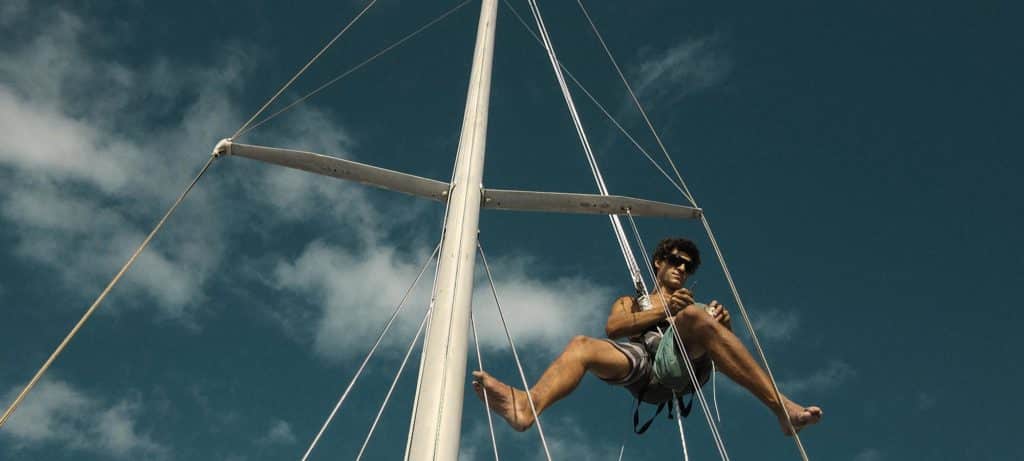
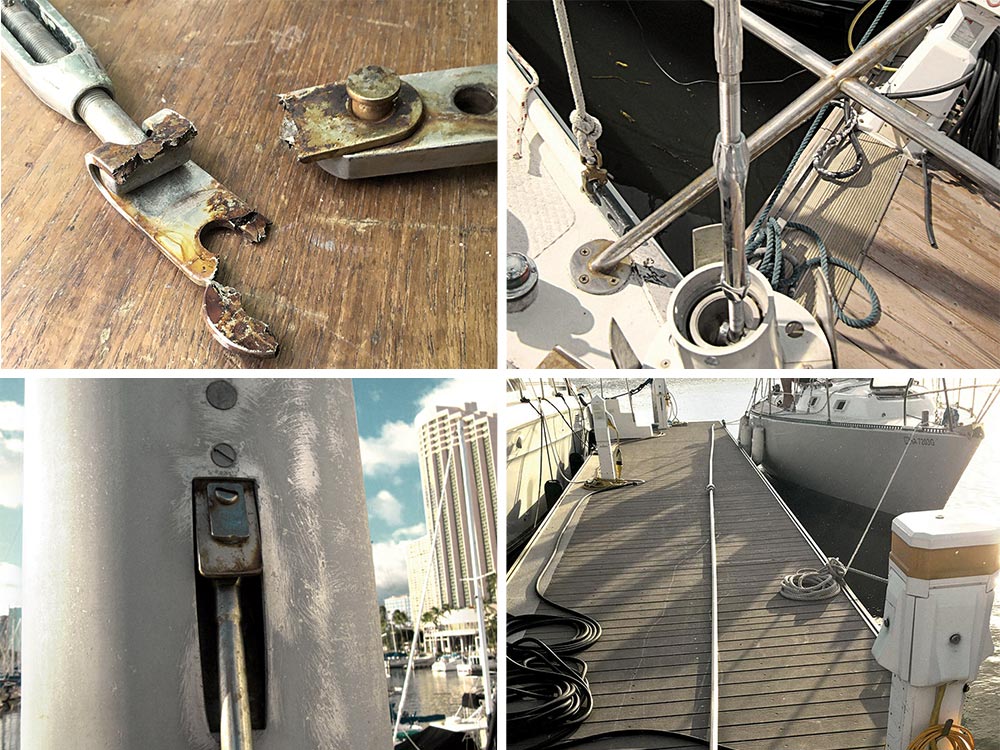
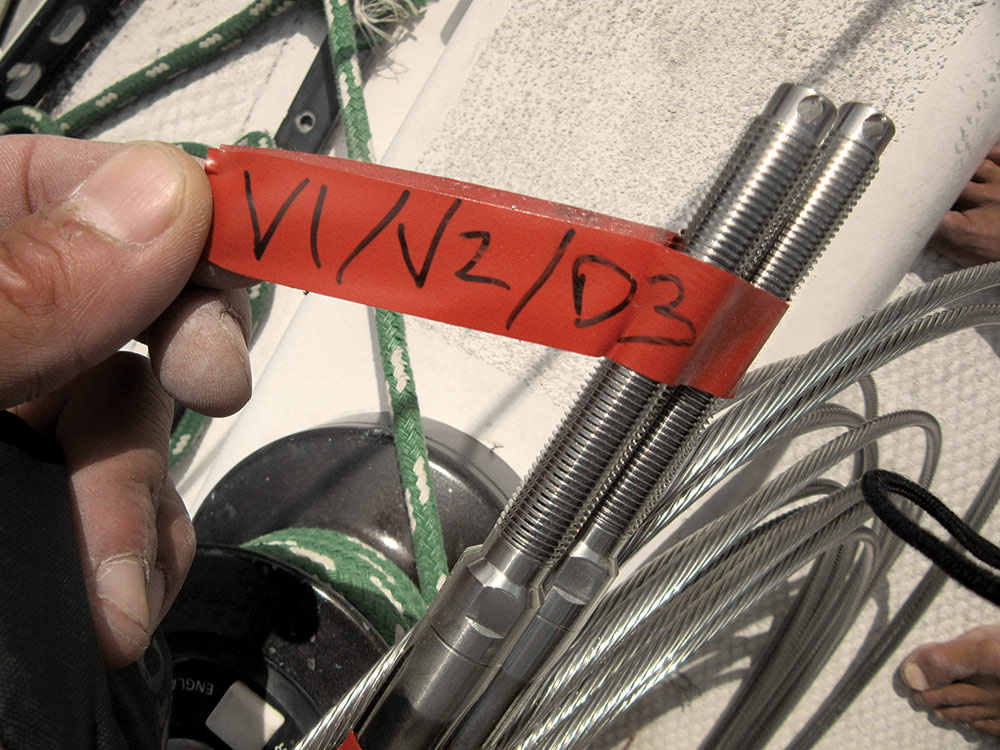
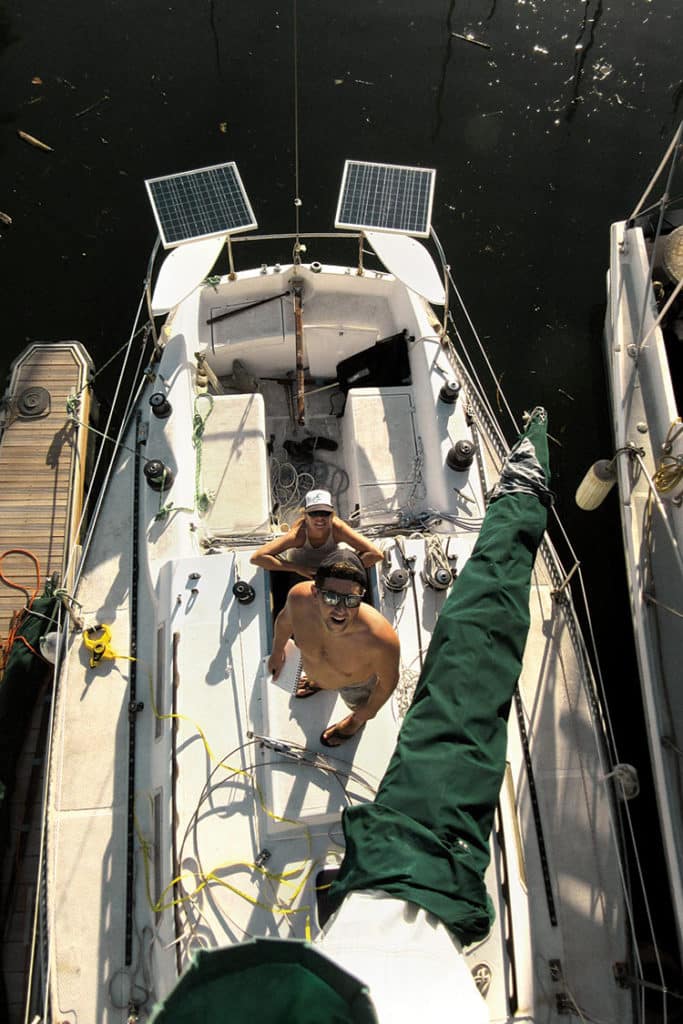
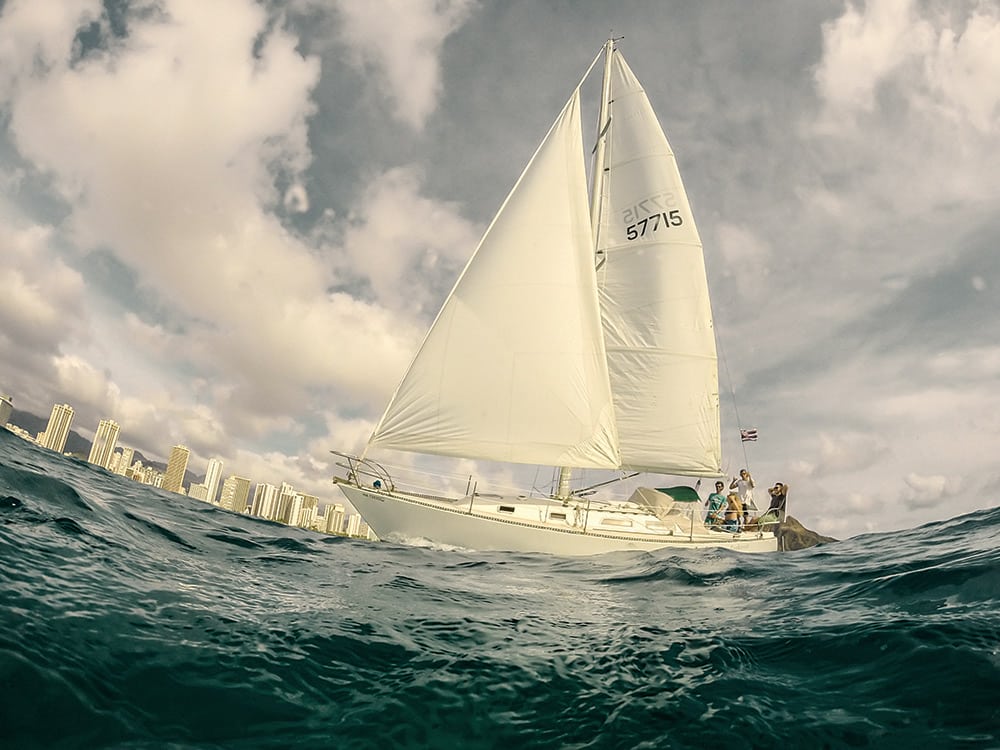





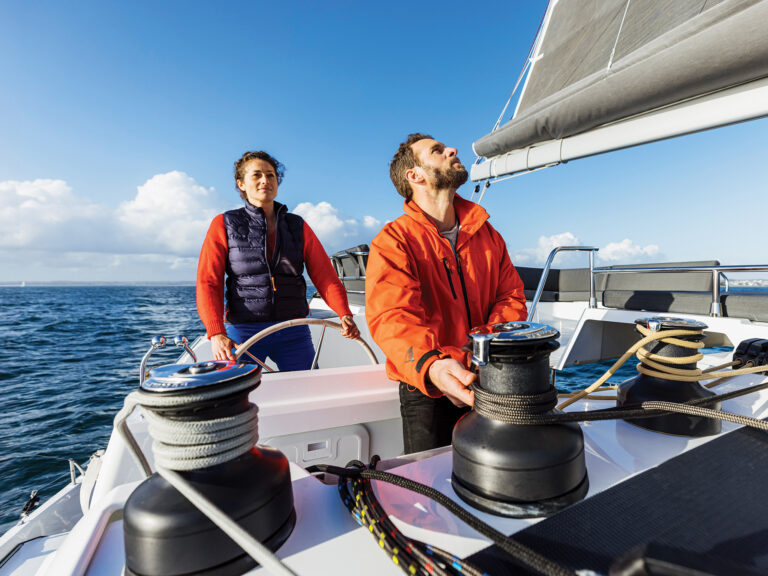






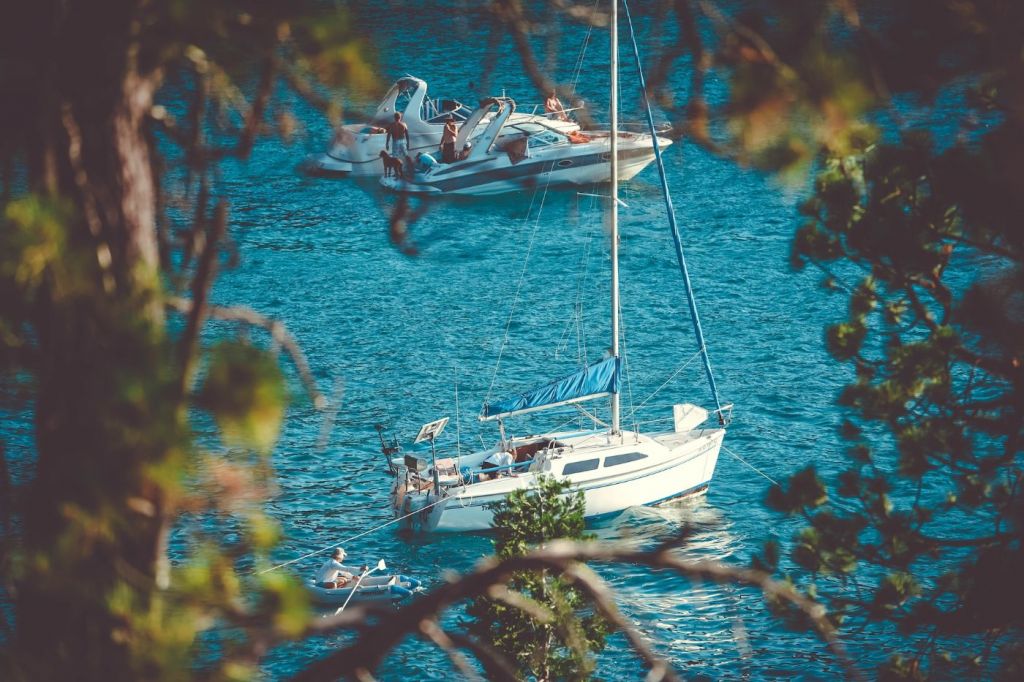
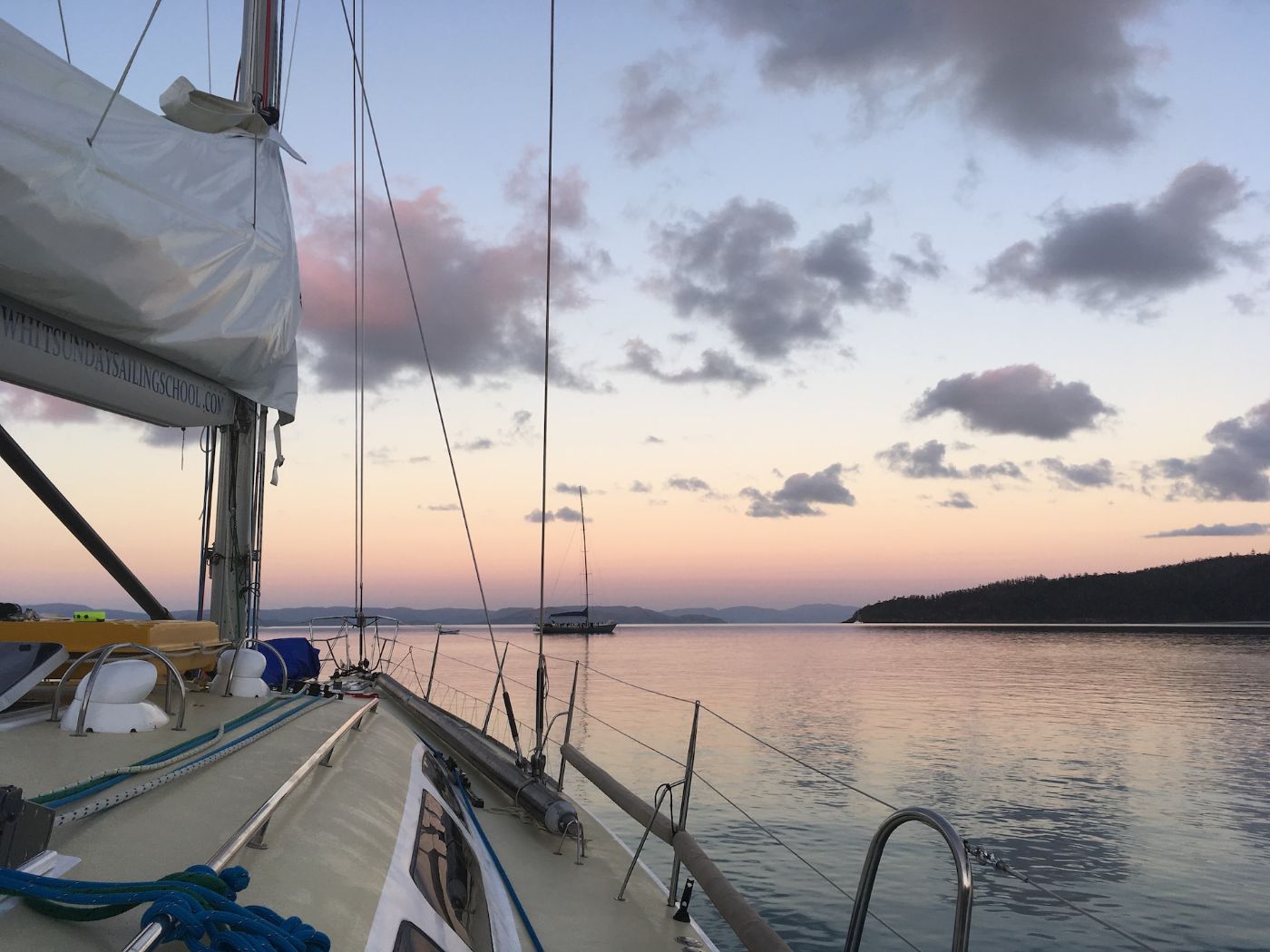
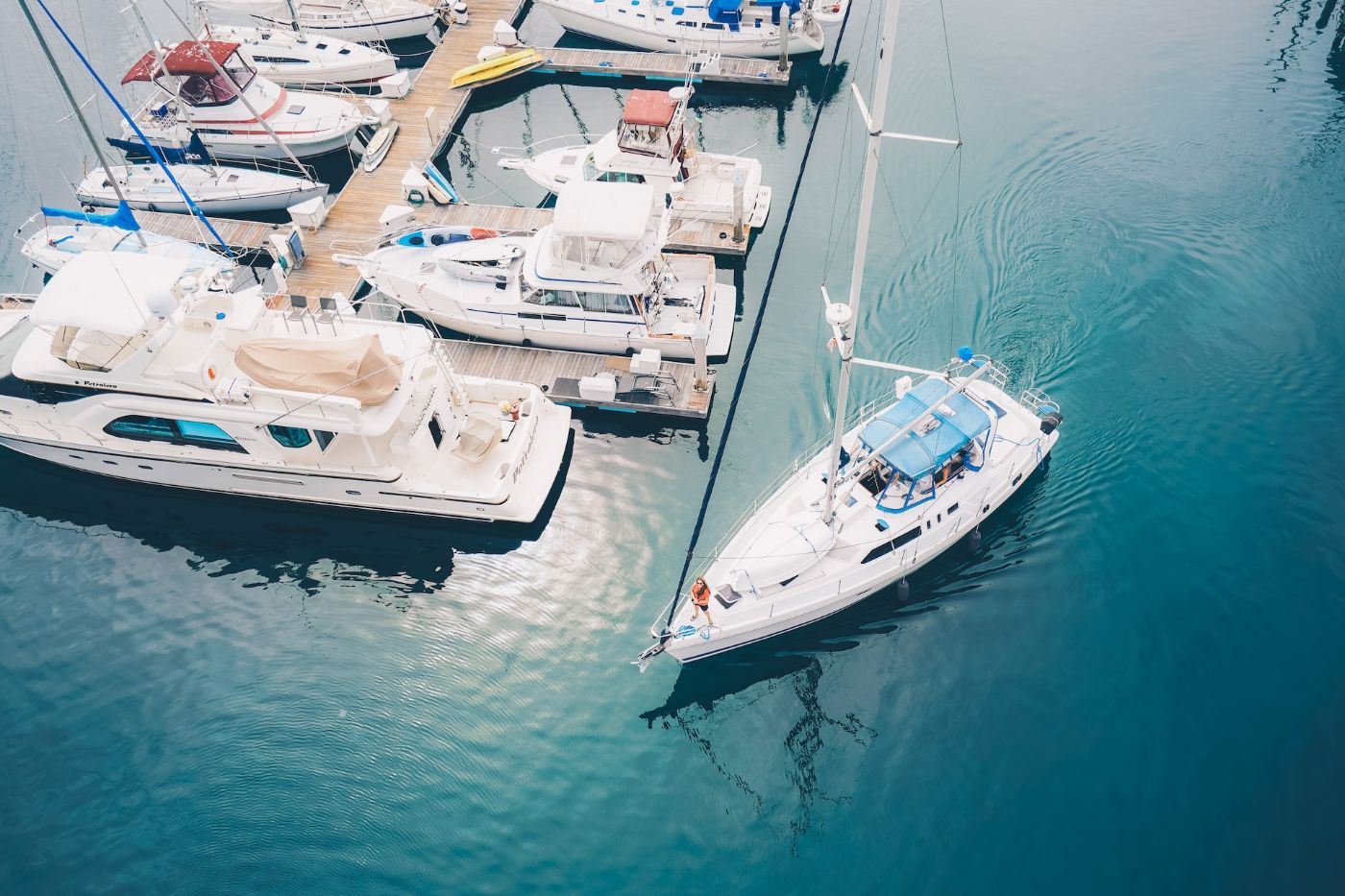

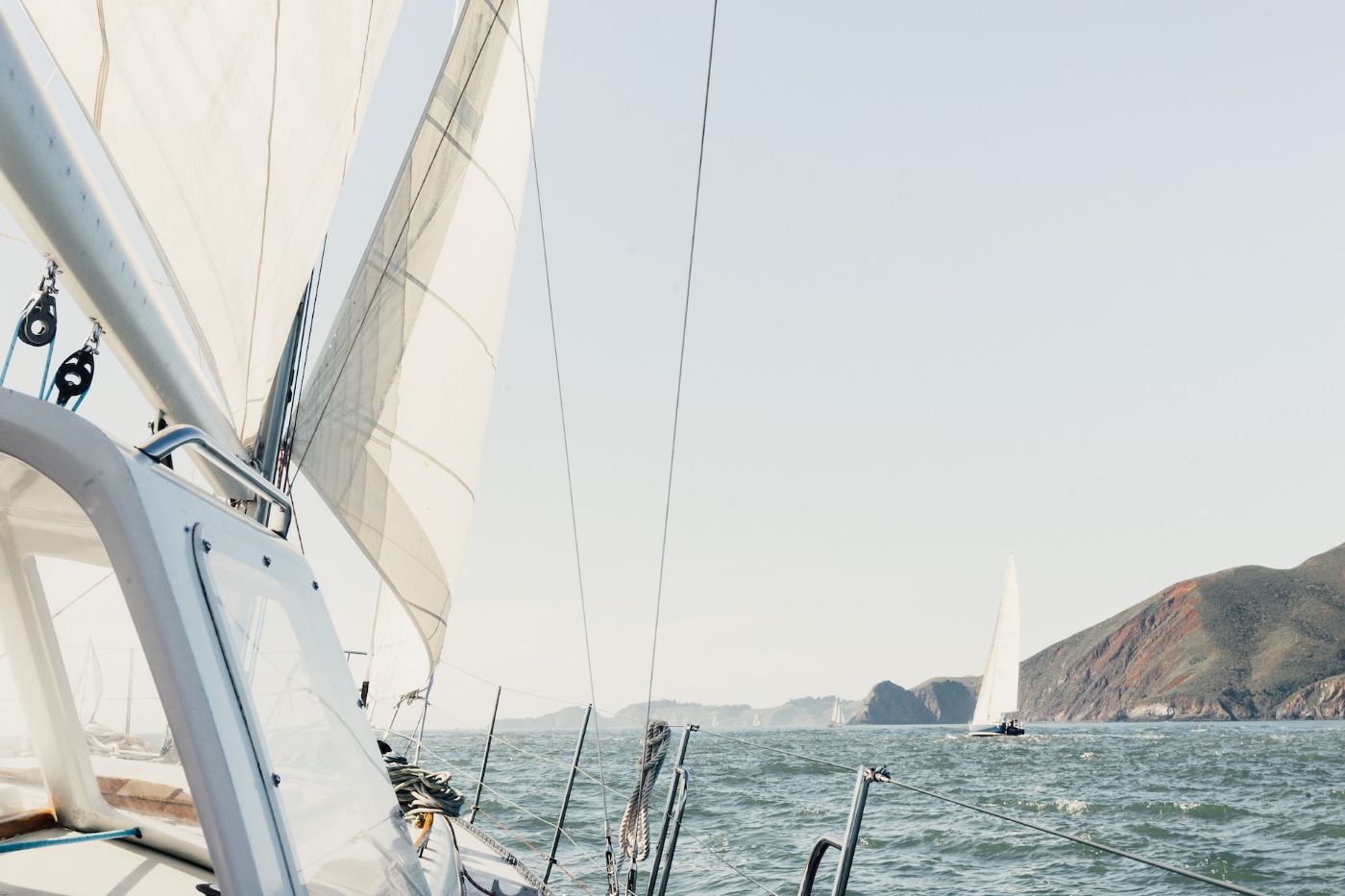



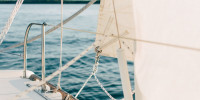
COMMENTS
Aug 14, 2015. It's one of the most important features on a sailboat, but many owners put standing rigging at the back of their minds when it comes time to do their pre-season safety checks. A prudent sailor should inspect his or her standing rig at least once each season and should know when the time comes to replace most or all of it.
The cost to replace standing rigging obviously varies from boat to boat. Give us a call, and we can give you a rough quote. With proper measurements (wire diameter, pin sizes, wire lengths), we can give you a very accurate price for the standing rigging itself, but there are often unforeseen complications during the job (bad spreaders, corroded ...
Small sailboat (up to 30 feet) A 25-foot sailboat may require replacement of the forestay, backstay, and upper shrouds, which could cost around $2,500 to $3,500, including the cost of the rigging and labor. For small sailboats, the cost of replacing standing rigging can range from $2,000 to $5,000.
Good question. Yes, doing it yourself will theoretically save money. For an average 40-foot boat, Cockerill estimates about $100 per foot to re-rig with wire rigging ($4,000), as well as the round-trip cost to haul and launch the boat and unstep and step the rig (an additional $2,500 or so).
Run your fingers up and down the last metre of wire above or below the swage, feeling for deformities; if the wire is not uniform the chances are that one of the individual wires has broken, even ...
This video is a guide to replacing your standing rigging leaving the mast in place. I did this by ascending and descending the mast solo 30 times, taking the...
Replacing the standing rigging on a sailing yacht, a complete re-rig, in other words, may seem daunting. Still, there is a procedure to follow that can make it a relatively straightforward process for anyone who is reasonably practical. The first decision is whether to tackle the job with the mast up or down.
That's what I call a no-brainer. Following are approximate costs per foot (in 2014) for standing rigging from several popular sources compared to the rigging company in my area. Popular online Catalina parts retailer: $4.00/ft. complete. West Marine: $1.02/ft. cable only. McMaster-Carr: $0.85/ft. cable only.
Installing Synthetic Standing Rigging. Phil Gutowski. Mar 30, 2021. Removing the mast in anticipation of the re-rig: it's a job more easily done on the hard. It was blowing 25 knots when the inner forestay let go. Eclipse, my 1984 Tayana 42, was screaming along on a broad reach just south of Saint Thomas. I had gone to raise the staysail, and ...
The rig or rigging on a sailboat is a common term for two parts: The standing rigging consists of wires supporting the mast on a sailboat and reinforcing the spars from the force of the sails when sailing. The running rigging consists of the halyards, sheets, and lines we use to hoist, lower, operate, and control the sails on a sailboat.
Replacing your standing rigging might seem like a daunting task, until you watch this video and see how incredibly simple it is to do!Patreon: https://www.pa...
9 The final step is to drop a marble-size dab of sealant into the terminal body. Then screw the body back on the head, tighten it all up nice and snug, and you're done. Do not tighten it up as hard as you can! Overtightening the terminal will damage the wire and cone inside. Mechanical Wire Terminals.
PLEASE NOTE: THIS VIDEO HAS BEEN UPDATED WITH ENHANCED GRAPHICS AND IMPROVED SOUND. CHECK IT OUT HERE https://youtu.be/tRgWtPaCQQcA beginners guide to sailbo...
There are a few approaches you can take in replacing standing rigging wire. You can pull off each wire, note its unloaded length and dimensions, and order a replacement with swaged ends top and bottom. You can also buy a spool of wire and a handful of mechanical fittings like Sta-Loks (www.stalok.com, (910) 259-3394) and build the wire right on ...
The standing rigging refers to the network of wires and cables that support the mast and allow it to bear the tremendous loads exerted by the sails. It acts as the backbone of a sailboat's rig, providing stability, strength, and balance. Understanding its importance is crucial for anyone who sets foot on a vessel with dreams of cruising or ...
When and why do you change standing rigging. Easy answer "before it can fall down.". There is sailors knowledge based on observations and experiences that have formed the rules of thumb. 6-10 years for salt water exposed rigging and 15-25 years for fresh water rigging. Rough guides that depend on location of the boats sailing experience ...
Replacement Cycle. Wire standing rigging on an offshore cruising boat should be replaced every 10 years, or 30,000 miles, whichever comes first. The time requirement is because wire is more prone to corrosion than rod (see below).
Sailboat standing rigging maintenance, repair and replacement with photographs. Helpful information on re-rigging your boat by Chuck Rose. Home. The Logbook. ... While it is possible to replace the rig with the mast standing, it is much easier and safer to work with the mast on sawhorses at waist level. If you are preparing for cruising or a ...
Total cost from riggingonly.com shipped to NC was $700. This included swaged on studs and eyes. It was very time consuming to measure and install all the rigging, especially running the forestay through the roller furler. The forestay wire came with an uninstalled staylock fitting. Very happy with the results.
A broken headstay led to a full rigging overhaul. Learn how one sailor transformed his broken boat back into a sailing machine. Standing Rigging Replacement Ronnie Simpson. Reaching out of the channel in a moderate breeze, Quiver leaned on her big, overlapping genoa and accelerated up to hull speed. Surrounded by a fleet of vessels of similar ...
The cheap part of re-rigging is the cost of the wire and fittings. The expensive part is paying for the labor to install the rigging. For reference the total cost of the wire and swaged end fittings for our 36' boat was only about $3500. We removed the rigging and sent it to Rigging Only in Fairhaven, MA. They duplicate the rigging and sent it ...
For a small boat (under 30 feet), you can expect to pay anywhere from $500 to $2000 for standing rigging replacement. For a medium-sized boat (30-50 feet), the cost will be somewhere between $2000 and $4000. And for a large boat (over 50 feet), you should budget for at least $4000, and potentially much more depending on the size and condition ...
The cost of replacing the standing rigging of a large sailboat. Replacing the standing rigging of large sailboats with a length of 40-50 feet ranges from £4,500 - £7,000, but in some, it can range from £10,000 to £30,000 or more. This cost can be affected by the complexity of the rigging system, the type of mast, and the number of shrouds ...